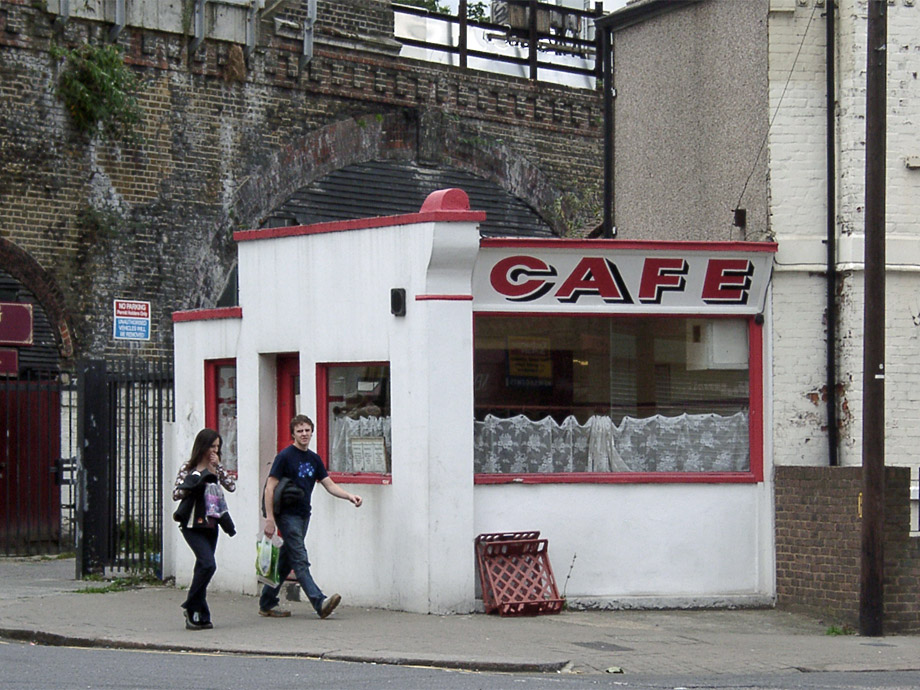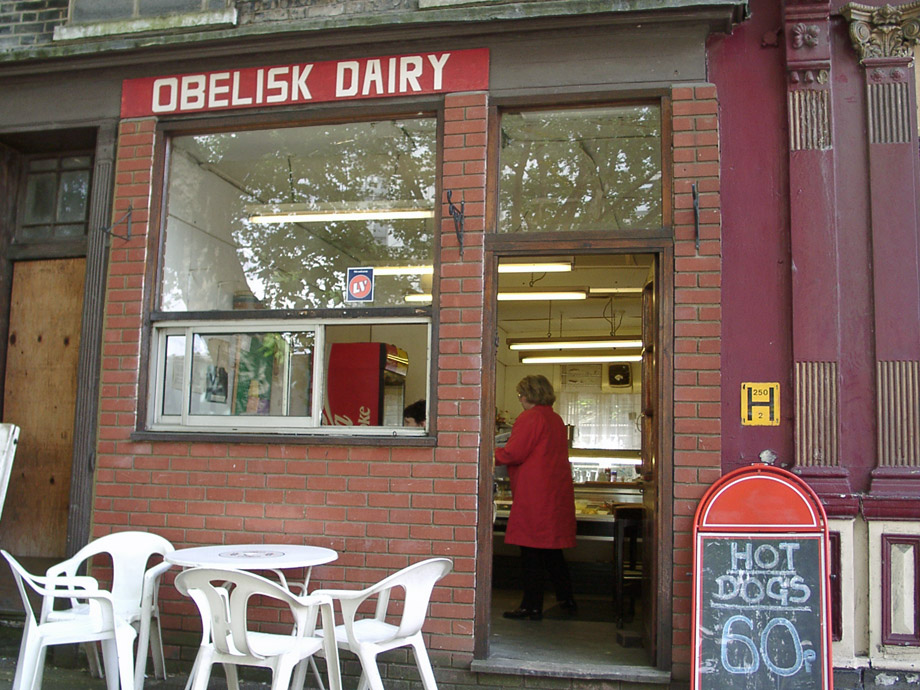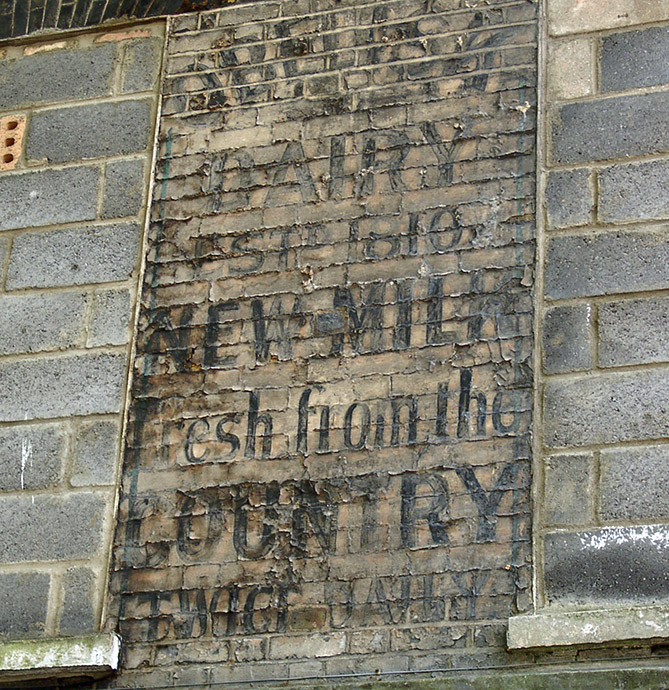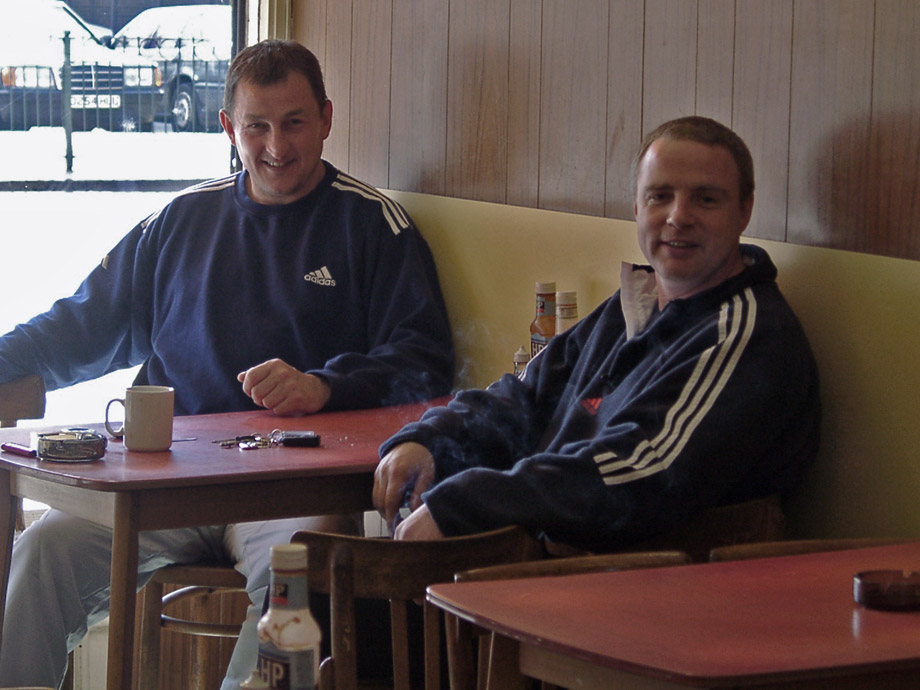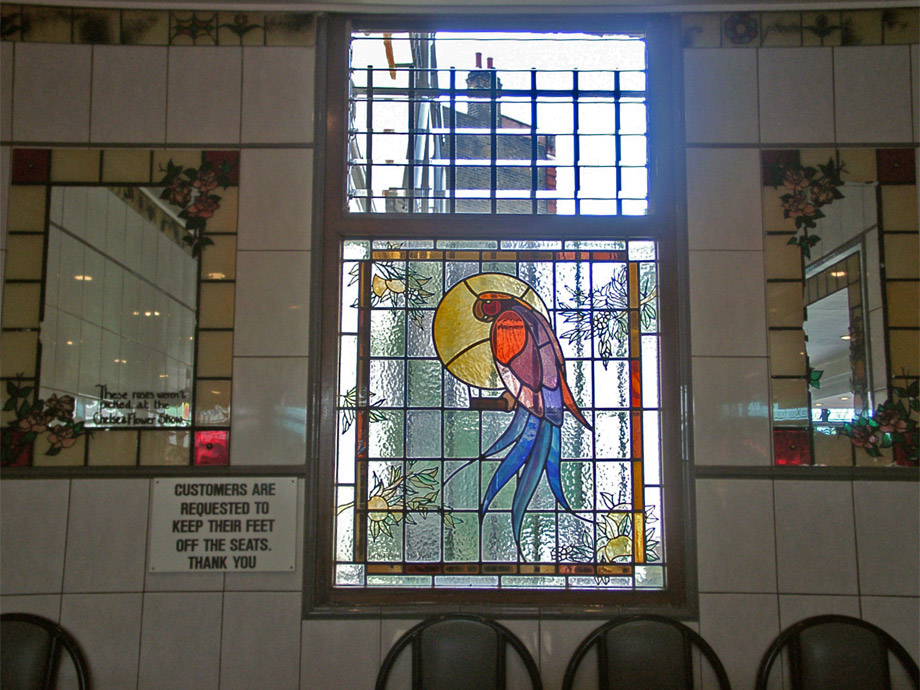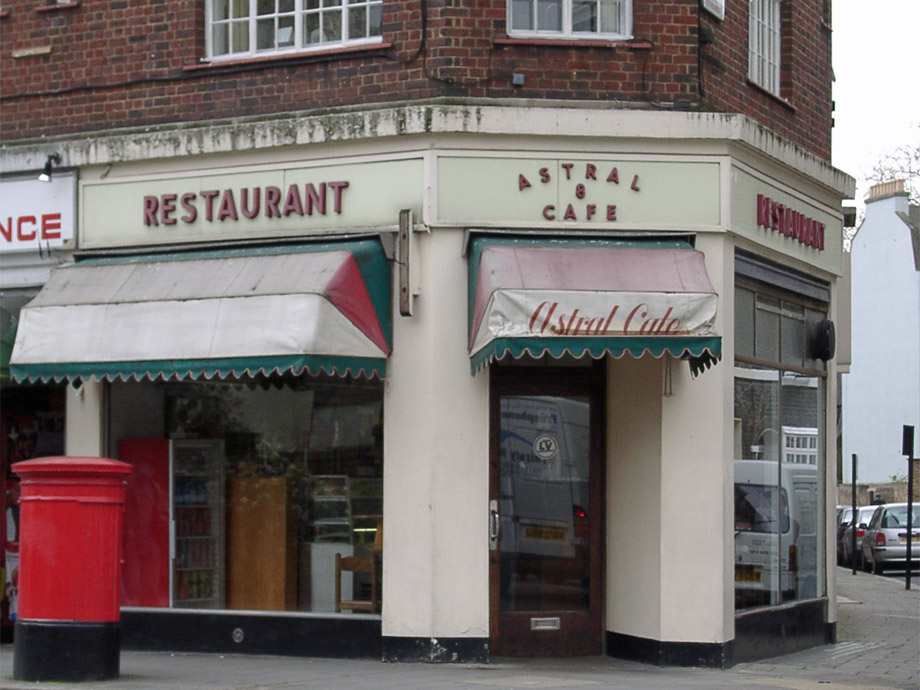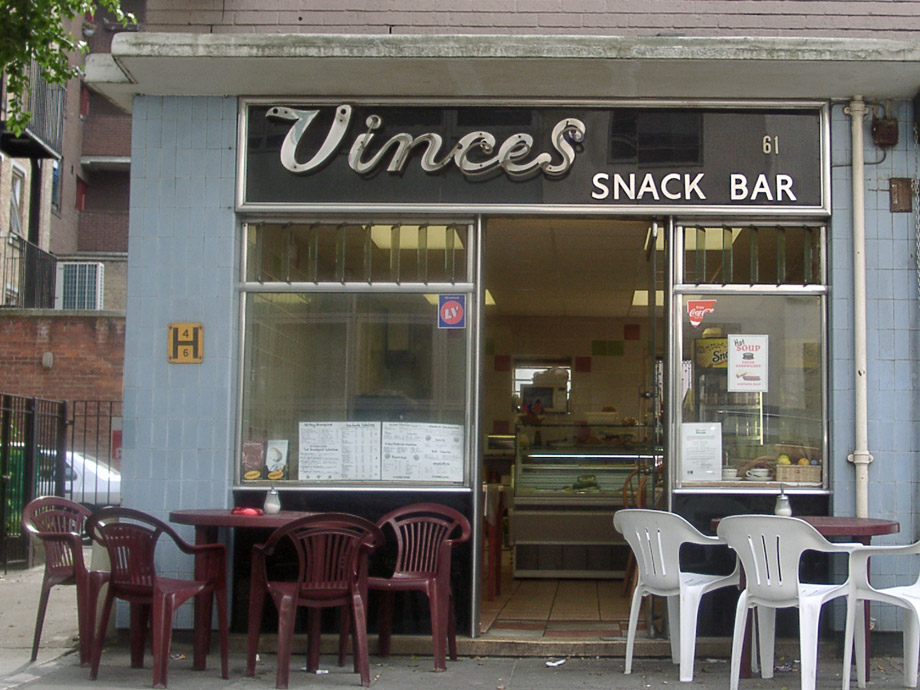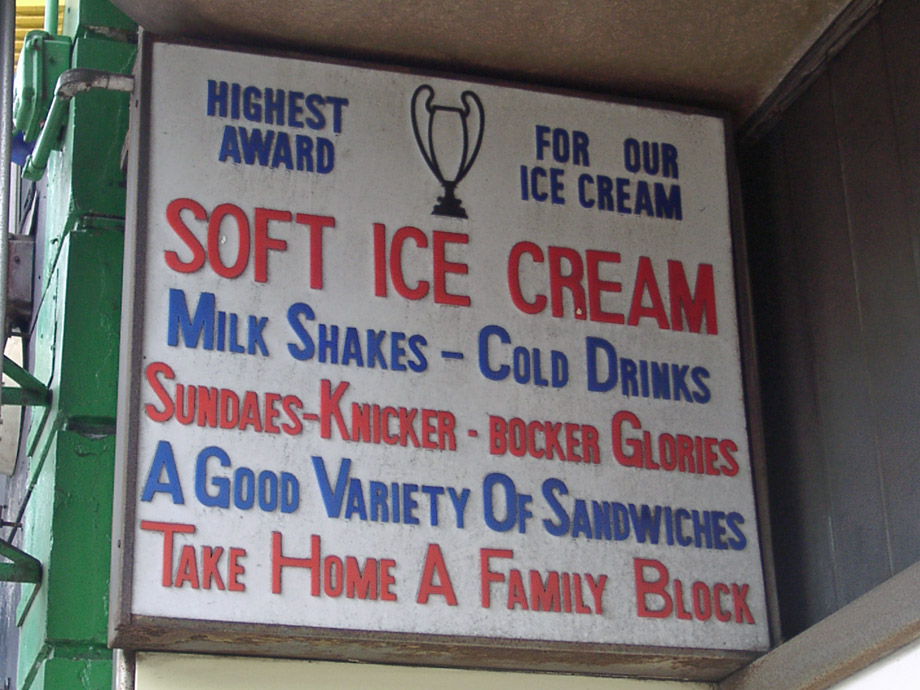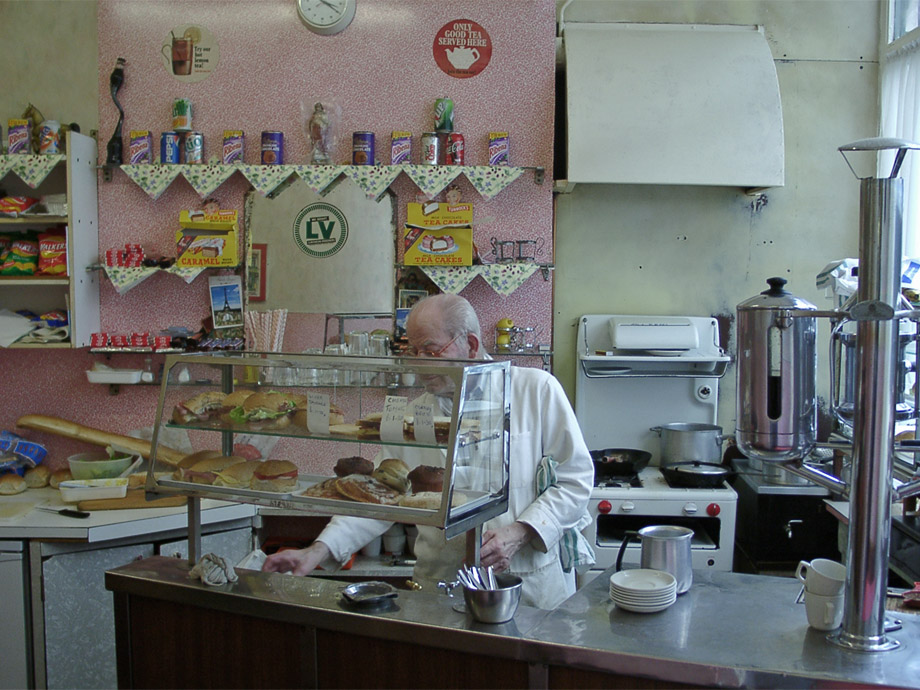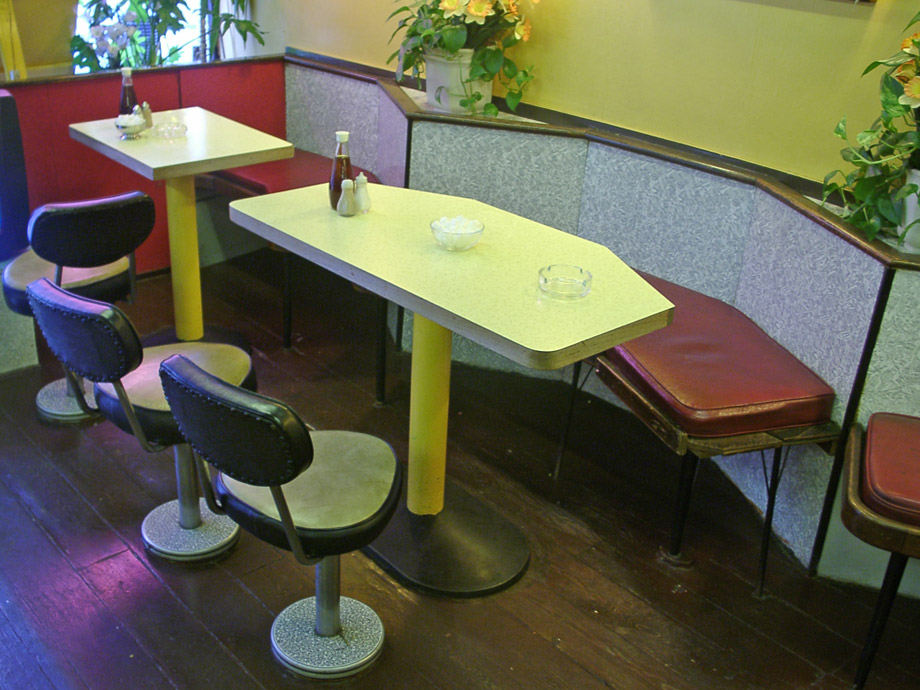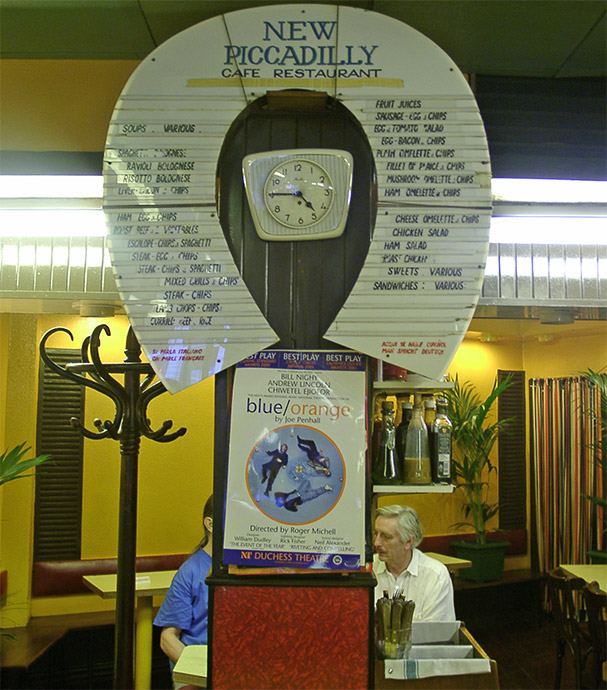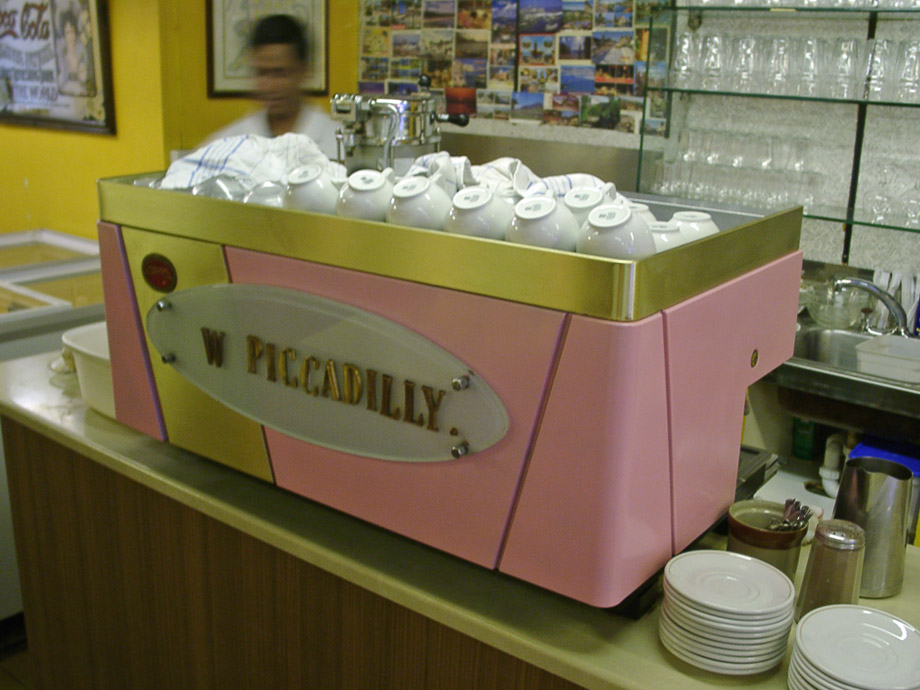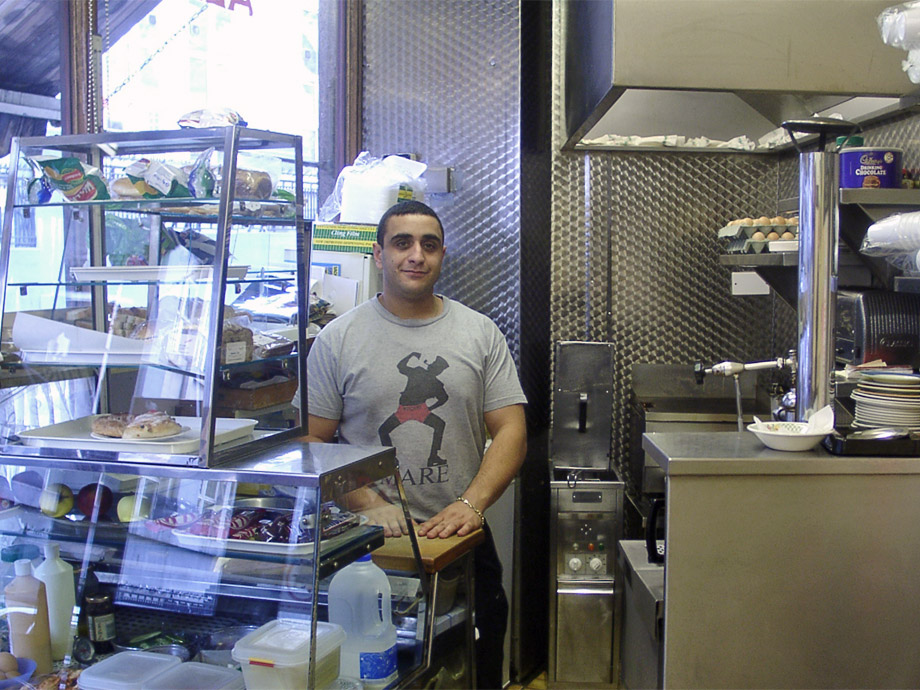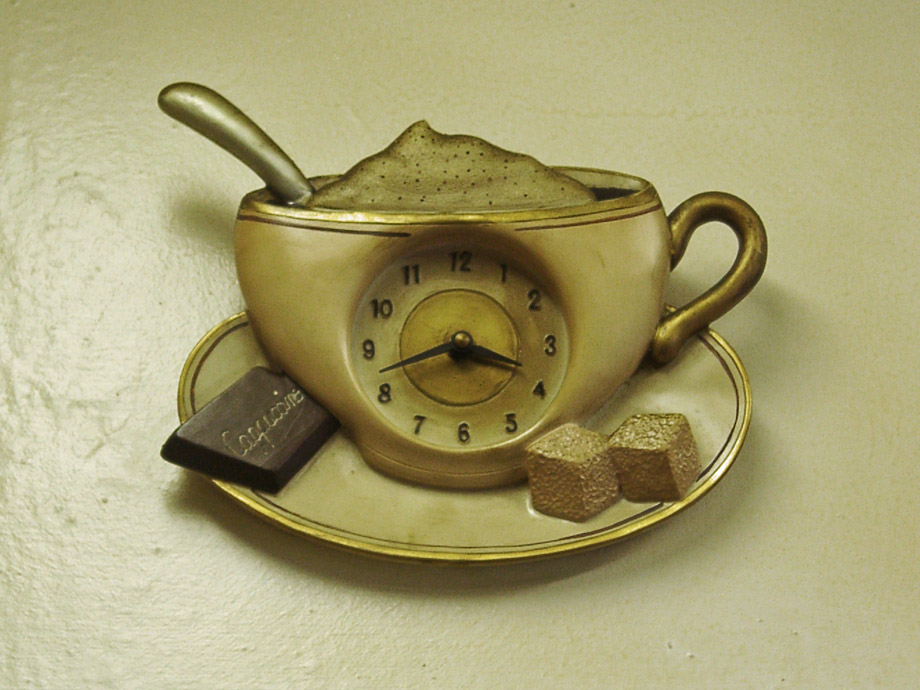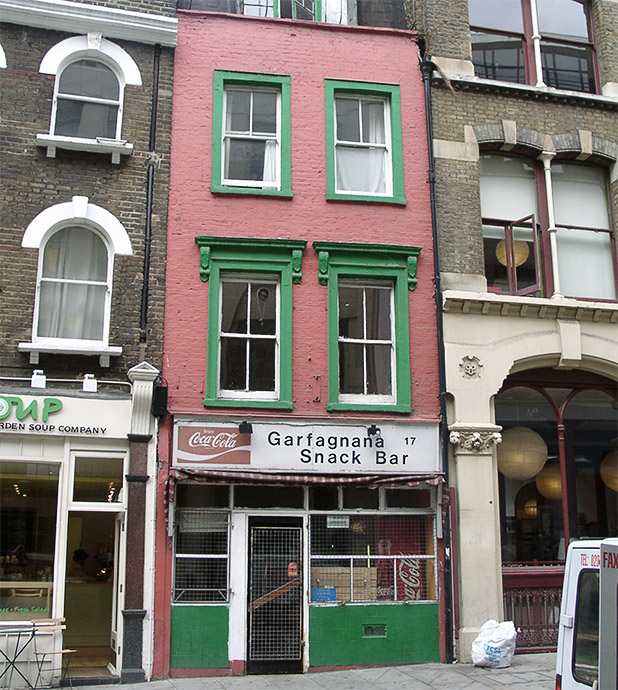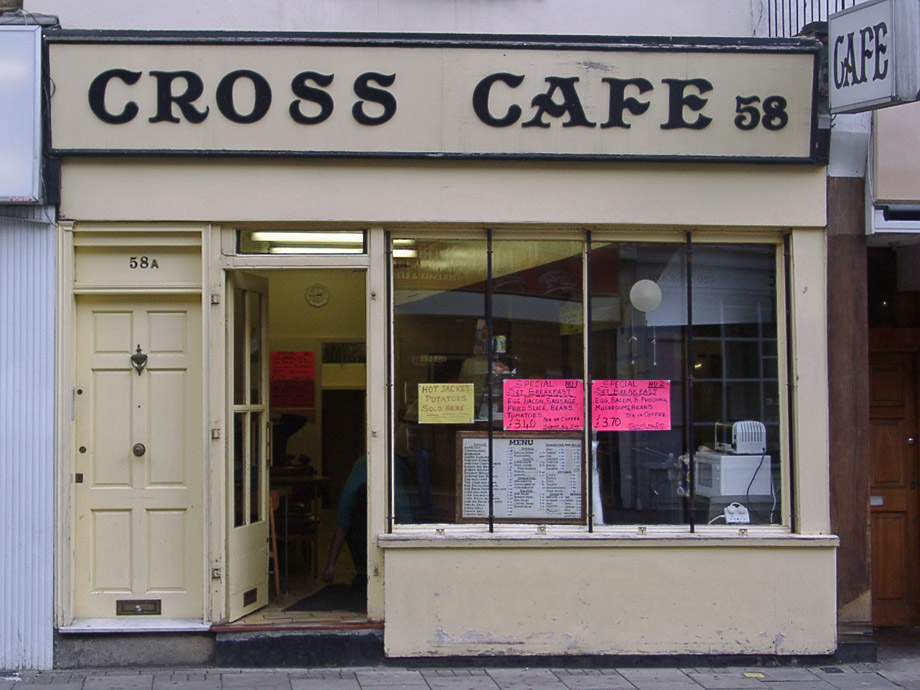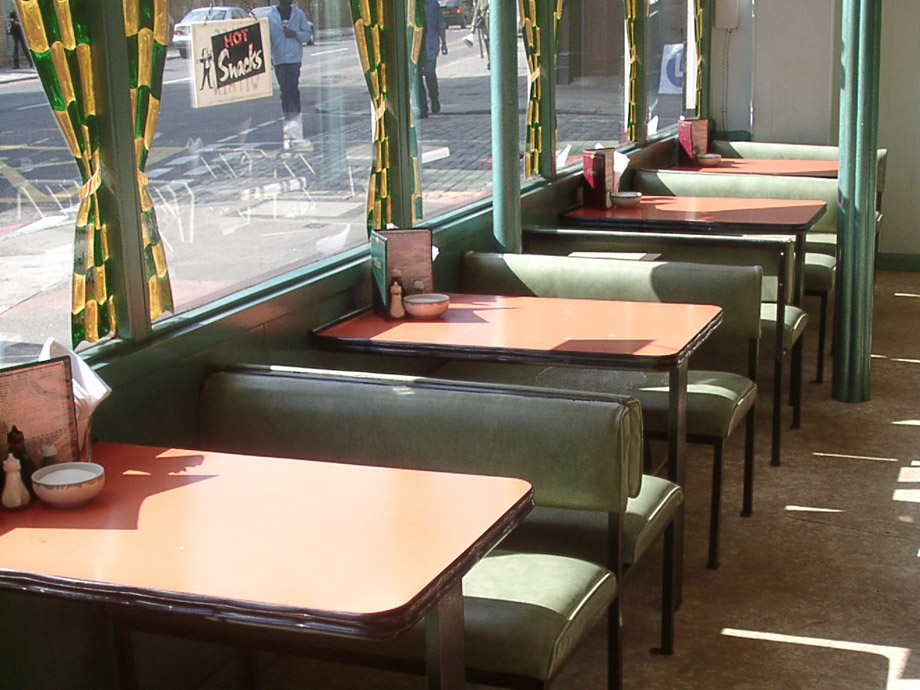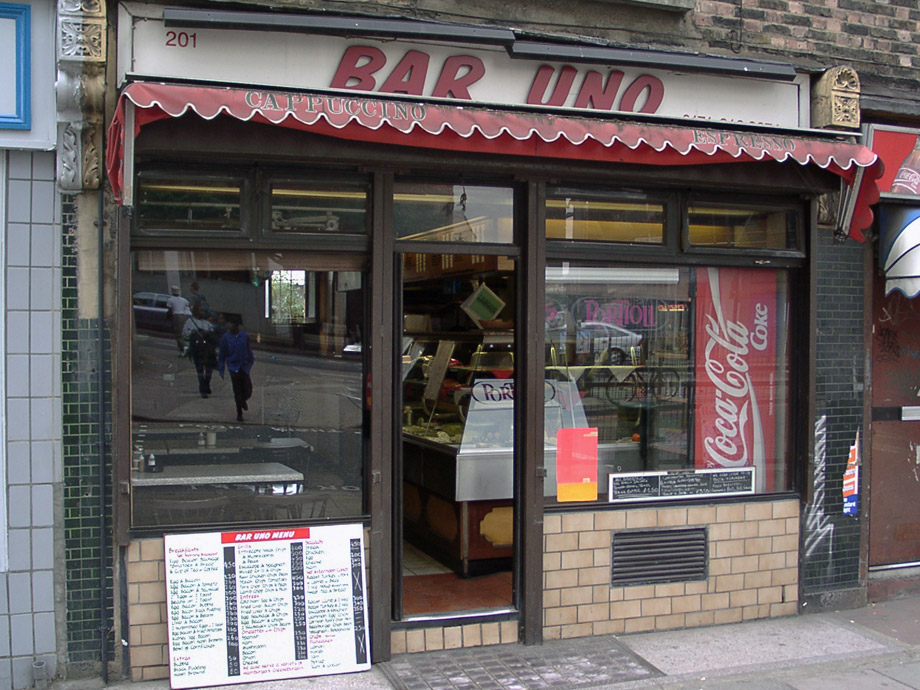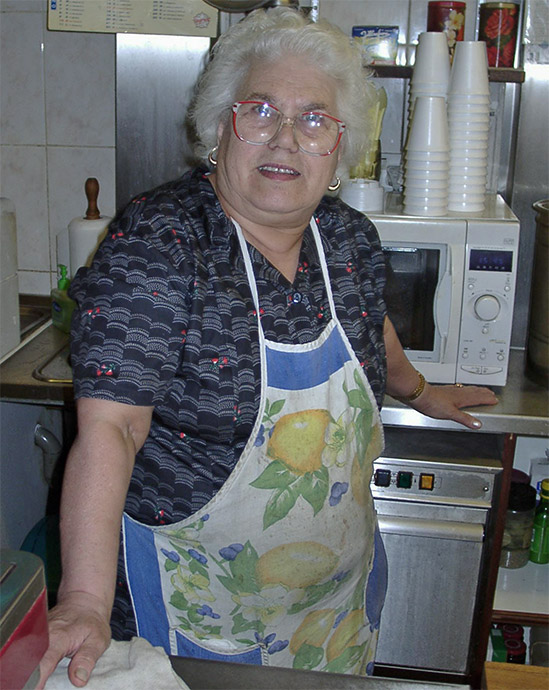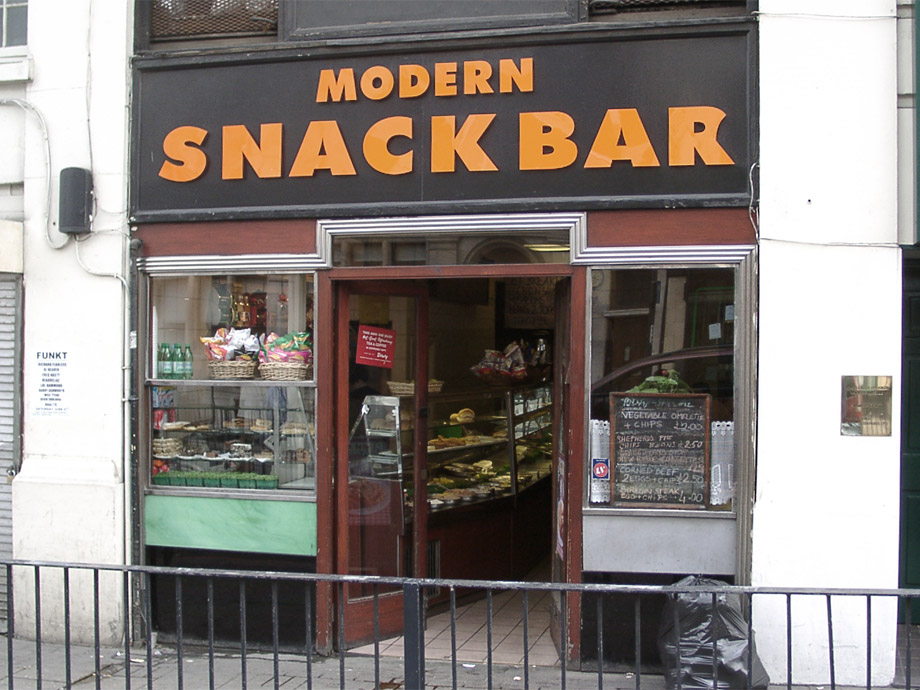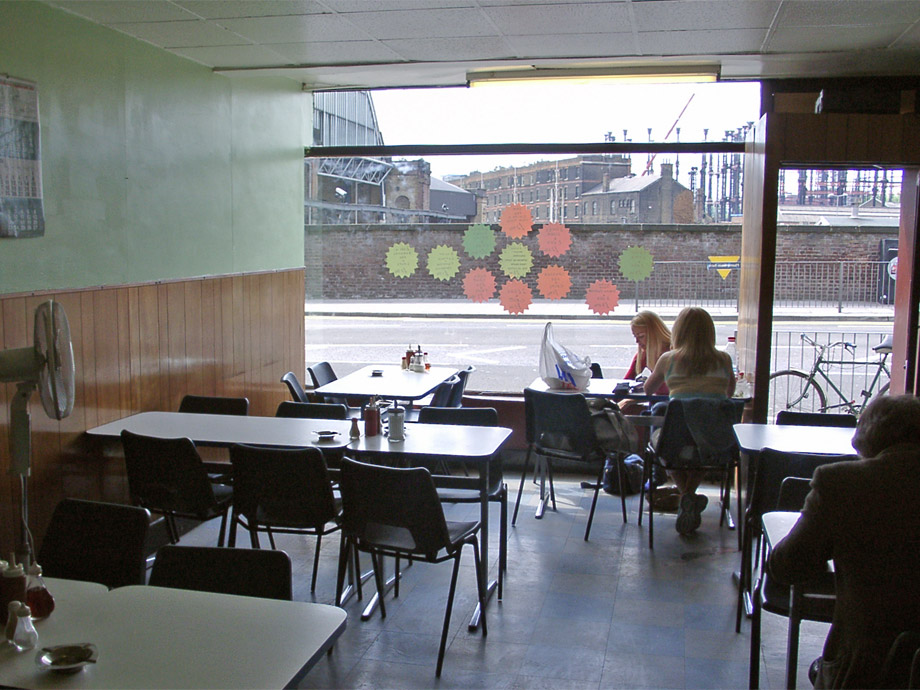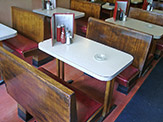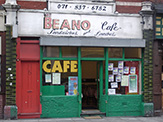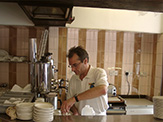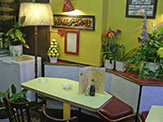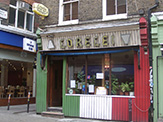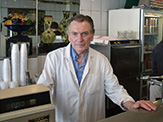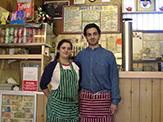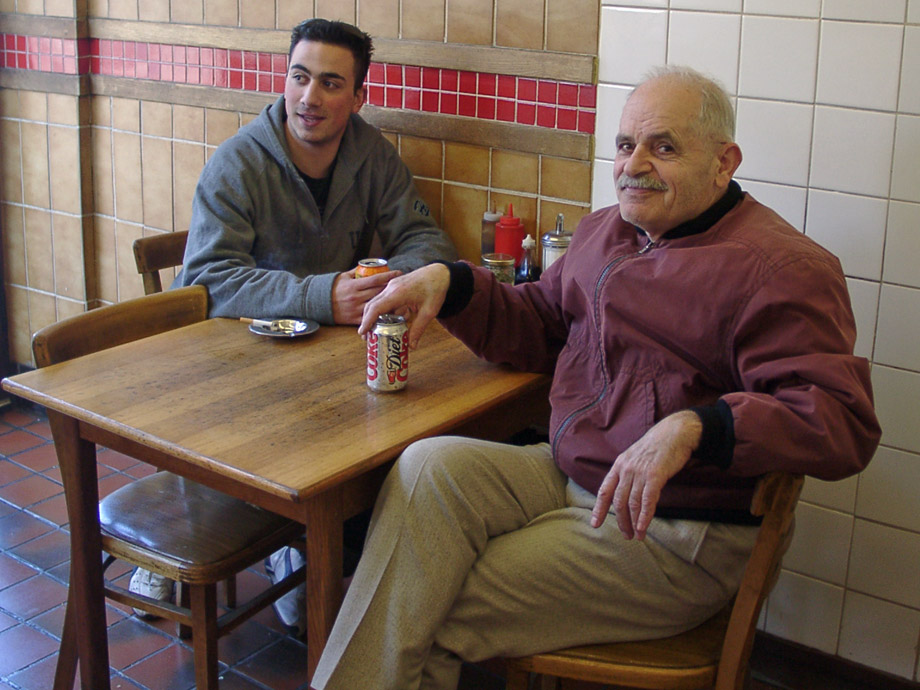
MORE SOUTH LONDON CAFES
This page gives only a cursory glimpse of a few cafes from across south London. A dedicated exploration of its vast railway suburbs would have found still-extant gems like West Norwood’s Electric Cafe and others which, I guess, might still be sunning themselves in two-storey terraced backstreets, next to MOT garages or builder’s yards or vacant plots overrun by buddleia: pieces to be added to an imagined personal utopia.
The photo at the top was taken in a place called simply ‘The Cafe’ which was on Battersea Park Road near the junction with Albert Bridge Road. The people running it were not only friendly but enthusiastic at getting their pictures taken. Unfortunately I was cack-handed with the camera and a photo of the proprietor grinning and holding a pie came out badly.
Small cafes colonising nooks and crannies were and are appealing. Towards the London Bridge end of Tooley Street was ‘My Tea Shop’, a mirror and formica-lined burrow in what must be the smallest occupied railway arch in the city. This served substantial fry-ups. It was run by an elderly Italian man and later taken over by an East European family who renamed it ‘My Tea and Coffee Shop’.
‘The Cafe’, pictured below, was at the junction of Florian Street and Putney Bridge Road – behind is the viaduct for the Wimbledon branch of the District Line. It’s still there, now named ‘The Florian Cafe’ and with a couple of tables and chairs set outside in fine weather.
Smaller still was the Obelisk Dairy which was on Borough Road by St George’s Circus. The whole block was clearly lined up for redevelopment so it seemed important to get a picture of the Dairy, even though it did a mostly takeaway business serving up rolls and sandwiches.
Above the Diary was this painted wall sign, reading: ‘Obelisk Dairy, Estd 1810, New Milk Fresh From The Country Twice Daily’.
The path towards the miniature leads at last to the functional purity of the tea hut and roadside snack caravan. At the time, I didn’t think to include these but this was probably a mistake. There was a good, green-painted shack under the railway bridge which spans Union Street off Blackfriars Road. For some reason the experience of having a sausage sandwich and polystyrene cup of tea on the shelf running along the shack’s front seemed best savoured early on a chilly morning.
A well-known tea hut still stands on the southern side of Chelsea Bridge. In an urban version of the familiar scenario where newcomers to the country complain about cockerels crowing, residents of Chelsea Bridge Wharf had tried to get it closed down, citing noise and litter. Pro-tea hut campaigners won the battle in 2014.
The last cafe in this series is the plain-looking Sun Cafe on Putney Bridge Road opposite Wandsworth Park. It was there in 1982 when I left school and got a job nearby. Now it’s gone, converted into a ground-floor flat.
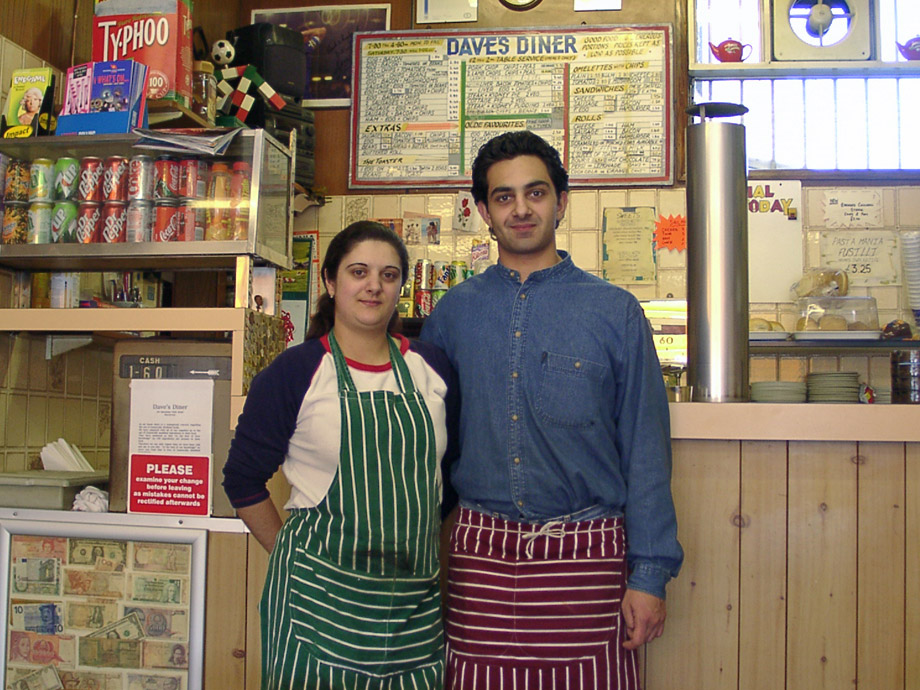
DAVE'S DINER, BATTERSEA
In the late 1990s I was living in Battersea in a ground-floor flat on Queenstown Road. It had an outside toilet subject to frequent invasions by slugs. To avoid stepping on them at night my flatmate took to urinating in bottles which he then hoarded in his room. To the uninformed, it looked like he was seriously into home brewing.
Queenstown Road then was in the early stages of a substantial change of character, just as many other parts of London were. The long post-war decline in population was starting to reverse. Some of the cafes in the area were doing quite well as a result, because large numbers of tradesmen were being employed on local house renovations and they needed somewhere to eat.
When I went back in 2001, most of the cafes along Battersea Park Road were unchanged, including Dave’s Diner. The young couple who ran it were cheerful and happy to talk, saying that business was doing well.
Several other cafes were along that stretch on the north side of Battersea Park Road, including the Jimmy Griddle and Corelli’s, the latter also a popular ice cream parlour. A more grotty greasy spoon lurked by the railway bridge to the east, and close by Queenstown Road station itself was the Corner Cafe, which is still there with its old ‘Dining Rooms’ wall sign visible (you can see it on Google streetview here).
The friendly atmosphere extended to at least some of the cafe’s customers that afternoon, like these two tradesmen.
Dave’s Diner must have closed fairly recently, as it still appears in some online listings. The premises are now occupied by a fried chicken shop.
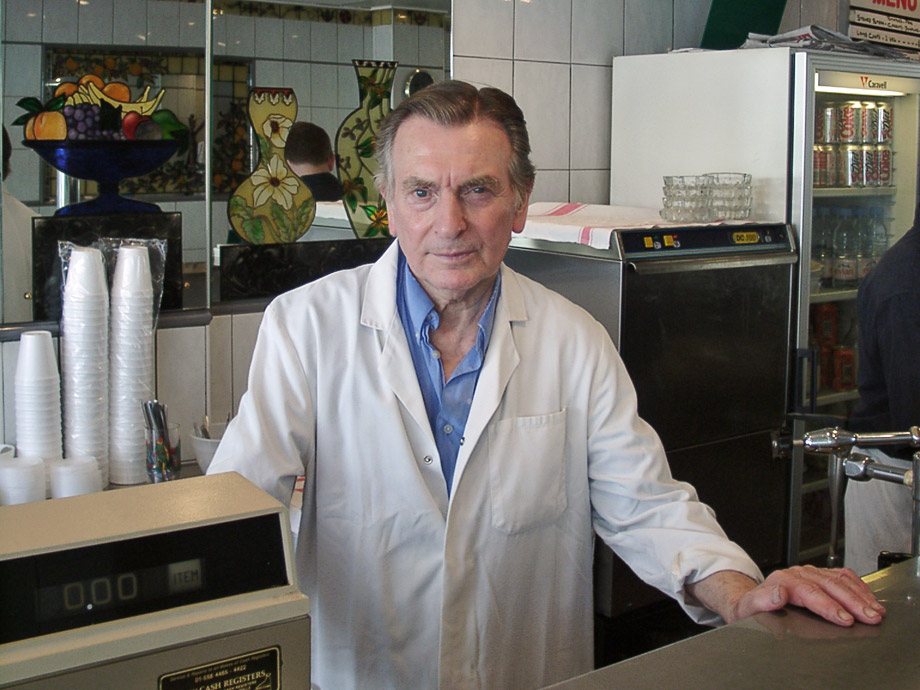
ARTHUR'S CAFE, DALSTON
Arthur’s cafe on Kingsland Road has, in recent years, attracted the attention of several blogs and even gained itself a favourable review by the Guardian newspaper. It’s one of three best-known cafes in east London. The others are the Market Cafe in Fournier Street in Shoreditch, made famous by Gilbert and George’s patronage but now sadly closed, and the beautiful Pellici’s in Bethnal Green Read, happily still going. I made a recording in the latter which you can hear on this page – you’ll need to scroll the box to the right of the map almost down to the bottom.
It’s the only cafe here from east London, which is partly because the photos of the few others I visited turned out particularly poorly. One of them was the Montgomery Cafe on Bethnal Green Road near the junction with Redchurch Street. Like the Market Cafe, it has now gone. The other reason is that I have never known east London well, having no friends there and no family connections other than a great-grandfather who worked at the London Hospital in the late 19th century.
The man in the photo above is Arthiur Woodham, looking confident and self-possessed in the premises where he’s worked since 1948, following on from his father. It was the early afternoon when I called round and the lunchtime rush had just come to an end. A couple of customers were about to leave, chatting with Arthur and saying their goodbyes.
The interior had been refurbished perhaps a few years before, looking clean and quite prosperous in the way that some of the cafes in the City do. The menu had reassuring staples like shepherd’s pie, stews, and liver and bacon, as well as fry-ups. If only more places did this kind of food! The walls are decorated with pictures and this small stained glass window, depicting a macaw, lets light in from the back of the cafe.
Arthur’s son is involved in the business, so with luck this fine cafe will be around for many more years.
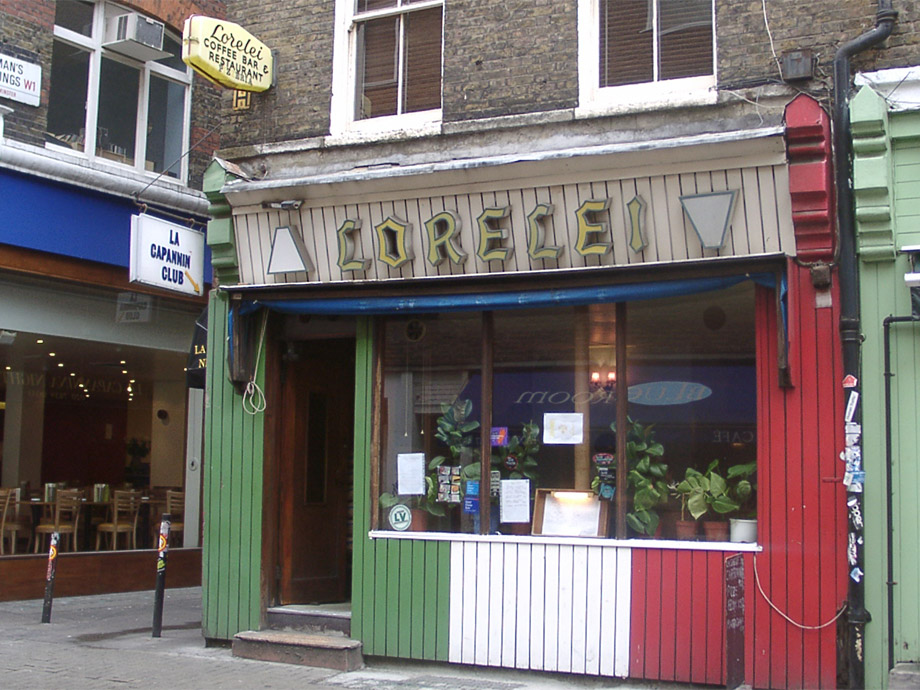
MORE WEST END CAFES
The Lorelei was on Bateman Street in Soho and closed down in 2013, its passing being noted in The Guardian and New Statesman. Like the Stockpot on Old Compton Street, now also gone, it was one of the cheaper good places to eat in the West End. The menu was dominated by pizzas (priced around £6) and simple pasta dishes.
The inside was a hybrid of lino-and-formica cafe and the dark woody Mittel European rustic look favoured by London’s older Italian restaurants. A mural covered most of one wall and depicted the cafe’s mythological namesake: a mermaid on a rock turning to gaze at an approaching sailing ship. To the left of the photo is a sign for La Capannina, which was then run by a Maltese man and popular as a hangout for strippers and other Soho nighthawks. It’s now under Chinese management and describes itself as an ‘exclusive gentlemen’s club’.
Quite close by on the west side of Charing Cross Road was the scuzzy-looking 101 Snack Bar. The man behind the counter had the manner of someone who’d just woken from a deep sleep. In answer to my request to take a photo inside, he nodded his head slowly, almost imperceptibly.
In its early days the 101 Snack Bar must have appeared bright and modern. By 2001 it had blended with the general air of rent-seeking neglect which then characterised the northern end of Charing Cross Road.
Fitzrovia was better known for its Greek and Italian restaurants along Cleveland Street than its cafes and snack bars. Below is Maria’s Sandwich Bar as it was on Grafton Way. Since then it’s had a makeover, perhaps to keep up with the newer coffee shops and sushi bars which have sprouted alongside the growth of offices and media firms in the district.
Vauxhall Bridge Road, Victoria Street and the Thames define a triangle enclosing an unusual and reserved part of London. It includes buildings and institutions such as MI5, Westminster Abbey, Tate Britain, Channel 4, the Labour Party’s headquarters, and Westminster public school. There are also the Peabody and Guinness Trust estates which replaced one of the most wretched Victorian slums in Britain, known as the Devil’s Acre. Like elsewhere in central London, there is little middle ground between the Georgian townhouse and the council flat.
A couple of small cafes off Strutton Ground serve residents from the old blocks of flats along Abbey Orchard Street and Great Peter Street. Further south, on Horseferry Road, is the Astral Cafe. In 2001 it was popular with cab drivers who used to park at the top of Maunsel Street close by. The food then was mostly of the sausage, egg, chips and beans variety and the unusual name was taken from Astral House, the corner block of private flats in which the cafe occupied the ground floor. It appeared in the video for the 1985 UK hit single ‘Take on Me’ by the Norwegian pop band A-ha. The cafe is still in business in the same premises.
Another survivor is the well-known Regency cafe, also on Horseferry Road. This large and quite grand-looking cafe has an interior that’s very clean and tidy in the masculine sort of way which pie-and-mash shops tend to have. It draws its clientele from surrounding offices and Channel 4 staffers wanting a change from their subsidised canteen.
Further along Horseferry Road, towards the Thames, was the Fiesta snack bar. It’s included here because of its attractive sign. Since then it’s changed hands and now presents a more modern and nondescript front.
A similarly attractive old sign adorned Vince’s on Red Lion Street in Holborn. The premises are now occupied by a Chinese takeaway. The street formerly had more evidence of the presence of an Italian community than it does today, with the Mazzini Garibaldi Cliub, a nice restaurant called the Conca D’Oro (now a Thai) and, a little further away, the Mille Penne.
The last establishment has been hopefully included here, because I can’t remember exactly where it was. I think it may have been on or somewhere near Edgware Road a short distance north of the junction with Marylebone Road.
It made an attractive sight with the chrome fittings on the front and its smaller plastic-lettered sign. The generic name makes it hard to find out anything more about the place, but if you remember it, please drop me a line.
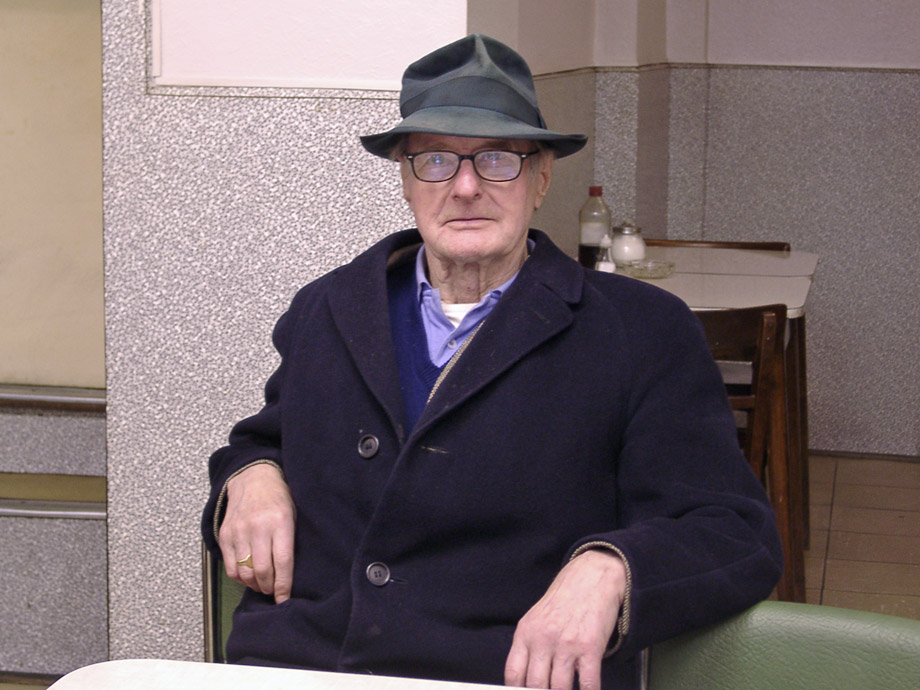
JOHNNY'S ITALIAN RESTAURANT, PIMLICO
Johnny’s Italian Restaurant was on Rochester Row close to the junction with Vauxhall Bridge Road. It was part of a small row of shops which included a tailor and a secondhand bookshop with copies of True Detective and other crime magazines in the window. Pictured above is Albert, one of the cafe’s regulars. The cafe’s sign bore the unadorned name of ‘Italian Restaurant’ but I heard local people refer to it as ‘Johnny’s’.

Johnny, or Gianni to give him his proper name, is pictured below. “I get called Johnny all the time so it’s stuck,” he explained. His parents had owned the cafe and he took over after they retired, moving back to London to do so. He also inherited several of his parents long-time customers, such as Albert above, and the day I spoke with him he introduced me to an elderly lady who travelled to the cafe once a week from Bromley. Gianni saw the cafe as a kind of community centre as well as a business, and he maintained that was one of the roles of old-school cafes in general. There was no real friendliness in the coffee shop chains.
Today the premises are still run as a cafe but under a new name and ownership. The interior has been changed with all the formica stripped out and the old Still water boiler got rid of – Gianni claimed these made the best tea and cafe proprietors liked to keep them going even though spare parts were becoming difficult to find.
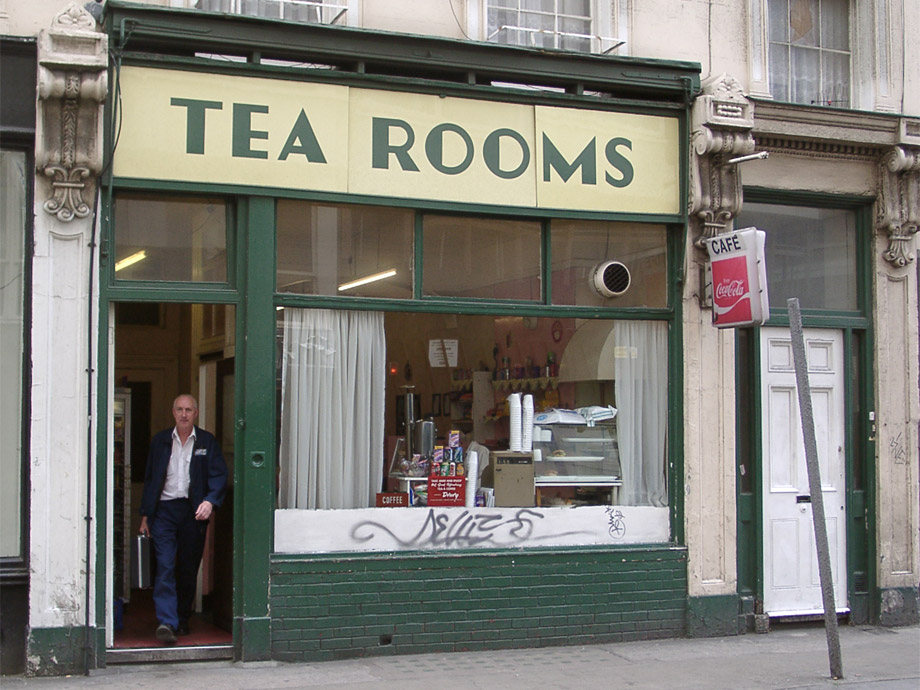
TEA ROOMS, HOLBORN
London is a built on a honeycomb world. Down below are voids inhabited by ghosts who mutter “ta” and “pardon” and form slow, shuffling queues. Bronze uplighters and caged bulbs throw a tired yellow light. Fire-buckets line the passegeways, filled with sand and cigarette ends, for here everyone smokes. The honeycomb world resonates to the faint pounding of pile-drivers on the surface in their unresting war against the past.
In time all things above ground will take their place here, some sooner than others. Depressions appear in the earth into which settle gentlemen’s outfitters, shops run by old ladies selling cake decorations and balls of wool, painted wall signs for razor blades and Mullard valves. The edges cinch up, the circle of daylight overhead shrinks to nothing, and the descent begins.
The Tea Rooms on Museum Street in Holborn have since been lost from sight. In 2001 they looked curious in an area dominated by more opulent-looking coffee bars and chain eateries, like the recluse’s house in a tidy suburban avenue.
The name and signage hint at the 1930s but their ownership until 2004 by the same couple suggests the Tea Rooms began life in the post-war period. Inside there was a room, singular, with pew-type seats and narrow formica-topped tables. Custom seemed sporadic and for some reason the attractive Art Deco disappeared before the cafe itself shut, perhaps sold to a collector or salvage yard.
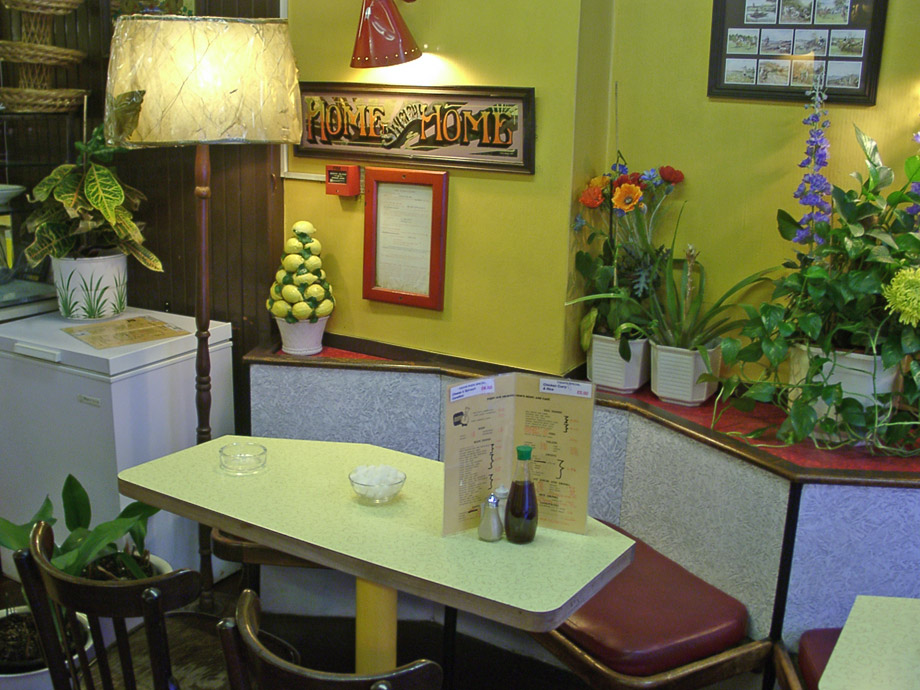
NEW PICCADILLY, SOHO
The New Piccadilly was a well-known cafe in a back street just to the north of Piccadilly Circus. Its exact address was 8 Denman Street, but due to some quirk in my mental map of the area I would sometimes make a wrong turn and have to retrace my steps.
It was an exceptionally attractive cafe, from the coffee machine painted the same shade of pink as Lady Penelope’s Rolls Royce in Thunderbirds, to the yellow formica table tops traced through with a sinuous pattern like curls of cigarette smoke. Lorenzo, the owner, had run it since the 1950s.
Nearby, towards the southernmost end of Regent Street, had stood a department store called Swann & Edgar where my uncle worked as a floor manager. Occasionally my mother took me to see him at his work and afterwards we’d go to a nearby cafe where I’d have a banana split as a treat. It’d be nice to think the cafe was the New Piccadilly but this seems too good to be true. The place I was taken to also had an orange squash machine with a perspex tank on the top full of squash. Inside this, two metal agitating arms spun slowly and a plastic orange bobbed on the surface. I think it unlikely Lorenzo would have tolerated the presence of such a gadget.
Lorenzo required his staff to wear starched white uniforms like ship stewards. Angled lighting directed illuminated pools onto some of the seats and tables and, wherever you looked, there some small ornament or decoration.
The New Piccadilly closed in late 2007 and I think it a terrible shame that no-one saw fit to grant it Listed Building status. Like the Golden Egg on Haymarket, with its egg-shaped menus and interior lit up like a Roger Corman film set, the New Piccadilly was one of the best representatives of its era and its closure represents a genuine loss to the city.
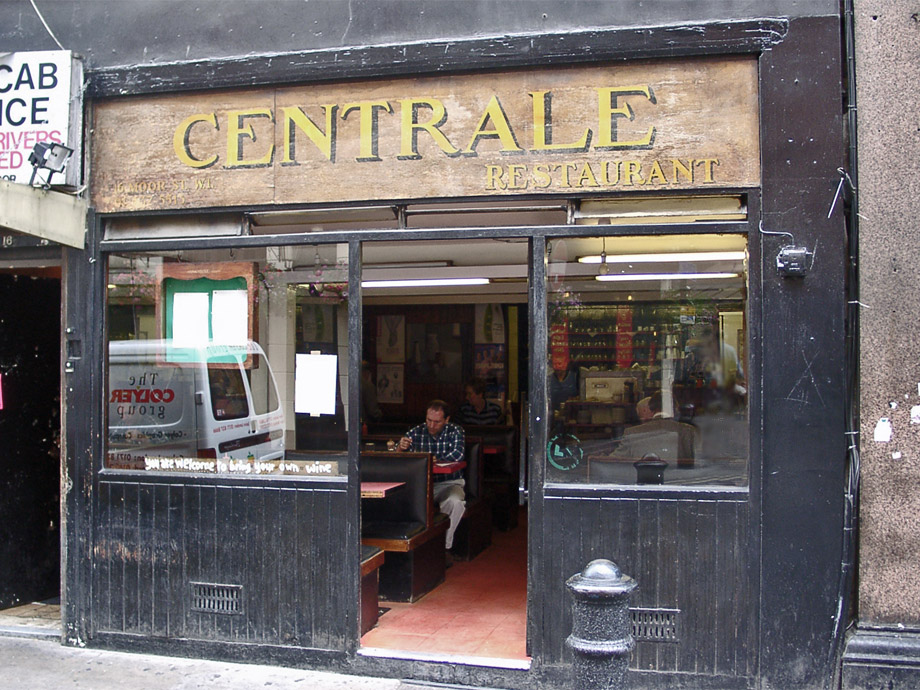
CENTRALE RESTAURANT, SOHO
In Western culture, female figures often symbolise nation-states or ideals such as liberty and justice. London’s West End would be better represented by a statue of a man complete with welcoming grin and outstretched arms: the hugger mugger. Paul Day, responsible for the embarrassing sculpture in St Pancras station of a pair of lovestruck Martian office workers, should definitely get the commission.
Londoners familiar with the West End treasure those small oases which offer respite from the area’s many overpriced disappointments and general in-a-hurry unfriendliness. My favourite was the Centrale Restaurant which stood on the north side of Moor Street near Cambridge Circus. This was run by a mother-and-daughter team whose surname I wrote down at the time in a notebook and subsequently lost – I think it was Mollinari. Both had a worldly unflappable air about them. Pictured below is their chef looking relaxed in his domain.

The Centrale was quite small inside with a worn pew-style vinyl seating and narrow tables topped with red formica. The cafe could get very busy and a common ritual was that of having to get up out of your seat so other diners could squeeze in past. This enforced closeness meant that strangers sometimes ended up exchanging pleasantries or even getting into more lengthy conversations, remarkable as this may seem in London. The floor was lino, the walls had a dark brown wood-effect finish. A sympathetic patina of age and use overlaid everything.
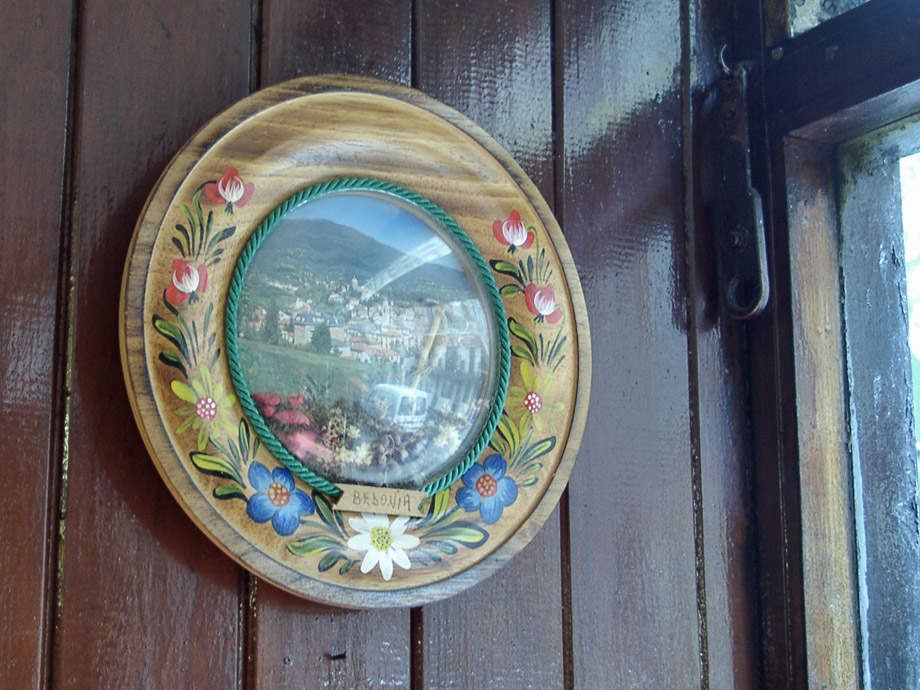
The menu never changed. There were omelettes, gammon steaks, things which looked like shnitzels, and pasta and gnocchi dishes. The basic sauce for the latter was quite creamy with a delicious savoury edge that might have come from capers. I should have asked for the recipe, but this was probably a closely kept secret. The portions were very generous and Centrale must surely have kept some of its poorer clientele away from the precipice of outright malnutrition.
Centrale closed a few years ago. Shortly before this happened, one of the women told me they were going to move to new premises in Soho and handed me a business card with the address on. It was somewhere towards the west side of Soho, perhaps Beak Street. But nothing came of this and Centrale shut for good to be replaced by a hotel.
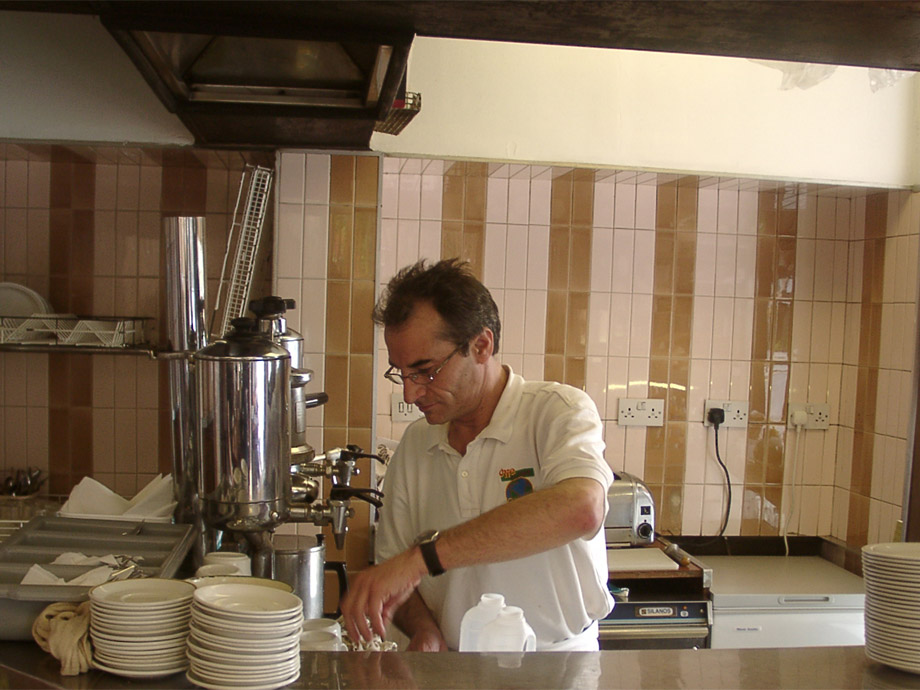
CLERKENWELL CAFES
London’s original Little Italy lay in a rough triangle bounded by Clerkenwell Road to the south, Rosebery Avenue to the west and Farringdon Road to the east. The spiritual centre of the district is St Peter’s church on Clerkenwell Road, from which issues the annual procession of Our Lady of Mount Carmel – you can listen to a recording of it on this page.
The Italian presence has dwindled and dissipated over the years, and several of the cafes shown here are now no more. Muratori’s was quite a large establishment at the top of Farringdon Road on the corner with Margery Street. John the proprietor was an approachable man, seen below next to the cafe’s gleaming Still water boiler. A crowd of cab drivers were among his regular customers and John would spend some of the time sitting at their table in conversation.
Alfie’s cafe was on Mount Pleasant directly in front of the sorting office. When I visited to take photos several of the Post Office workers were sitting inside the small cafe or on the aluminium chairs arranged outside. By this time I’d printed out some of my cafe photos to put in a ring binder to show people, and both the postal workers and the proprietor looked at them with polite interest. If the proprietor was indeed called Alfie, rather than named in honour of the Michael Caine character, then that’s Alfie pictured below.
Below is one of the small ornaments decorating the inside. A cafe called ‘First Class’ today stands on the same site, with a sign in the window telling passersby that ‘Good Hygiene Ensures Good Health’.
From the junction of Mount Pleasant and Rosebery Avenue extends a triangular plot of land occupied by Barnstaple Mansions, a late Victorian block of mansion flats with shops on the ground floor. There’s a lot of traffic noise and grime around here, and while Rosebery Avenue north of the junction with Farringdon Road has some attractive stretches, the part to the south has more the feel of an arid canyon filled with anonymous and transient life. Somehow despite all this, the flats in Barnstaple Mansions sell for nearly half a million pounds.
Luigi’s cafe was a small, slightly forlorn snack bar on the Rosebery Avenue side which seemed to be entering its terminal phase. The interior was dowdy looking and the proprietor was a woman with a worried, distracted manner. She asked me not to take any pictures inside so I didn’t. Today in its place stands Luis Cafe, which does seem like a truncated version of Luigi’s as if some of the letters had dropped off the original sign to make a new word. It looks a lot brighter and livelier.
Immediately to the south of Smithfield market are two long-established cafes. The Smithfield Cafe on Long Lane is one of London’s very few 24-hour cafes, alongside the likes of the Polo Bar opposite Liverpool Street station. Beppe’s on West Smithfield is larger and more comfortable, but both do fry-ups with extras like black pudding and fried slice, superior to the all-too-common standards of undercooked bacon and cheap catering-grade sausages.
Pricey restaurants and millenial grub options like burritos dominate the area to the north of Smithfield. In 2001 there were some exceptions, such as the Garfagnana on Cowcross Street. I have a weak spot for painted brick buildings so took a photo. The cafe had extra seating upstairs on the first floor, and I think the family who ran the cafe lived on the top floor. Garfagnana is a region in Tuscany, so you might guess that’s where they were from.
Boggi’s had already closed down by the time I took this photo in a small side street running west off Farringdon Road. For a modern-day survivor from about the same era, there’s Scotti’s Snack Bar on Clerkenwell Green.
In 2001, Leather Lane market was predominantly for non-perishables, like cheap clothes, five-lighters-for-a-pound, plastic bangles and other accessories. Like the small market at Strutton Ground off Victoria Street, it depended largely on a lunchtime office worker clientele. Since then, it’s been reinvented as a cooked food market selling things like falafel wraps and noodle dishes which you can eat with your fingers or poke at with a plastic fork.
This change has been mirrored to some degree at Brick Lane, and it was rumoured that Westminster council wanted to do much the same for Berwick Street market. Such places are now primarily tourist destinations, suitable backdrops for the smartphone on its selfie stick.
The cafe below was in one of the small streets running between Leather Lane and Hatton Garden. I never saw it open, yet it seemed slightly too opulent to be abandoned. An air of mystery hung over this Marie Celeste of the cafe world.
The market on Whitecross Street has changed much as Leather Lane or Broadway Market have. The Barbican Grill was one of several cafes along it, but it’s gone now. The word ‘Grill’ in a cafe’s name used to suggest something a bit more upmarket than a workmen’s greasy spoon, as with the old Clarendon Grill occupying the ground floor of the Clarendon Hotel on Hammersmith Broadway.
The Clarendon Hotel was a great place, with the moodily-lit Grill, and the basement which was used for club nights including one run by Stevo of Some Bizzare records. Upstairs was used for record fairs but had odd hidden corners, such as a room decorated with Masonic symbols and another used by the Royal Antediluvian Order of Buffaloes.
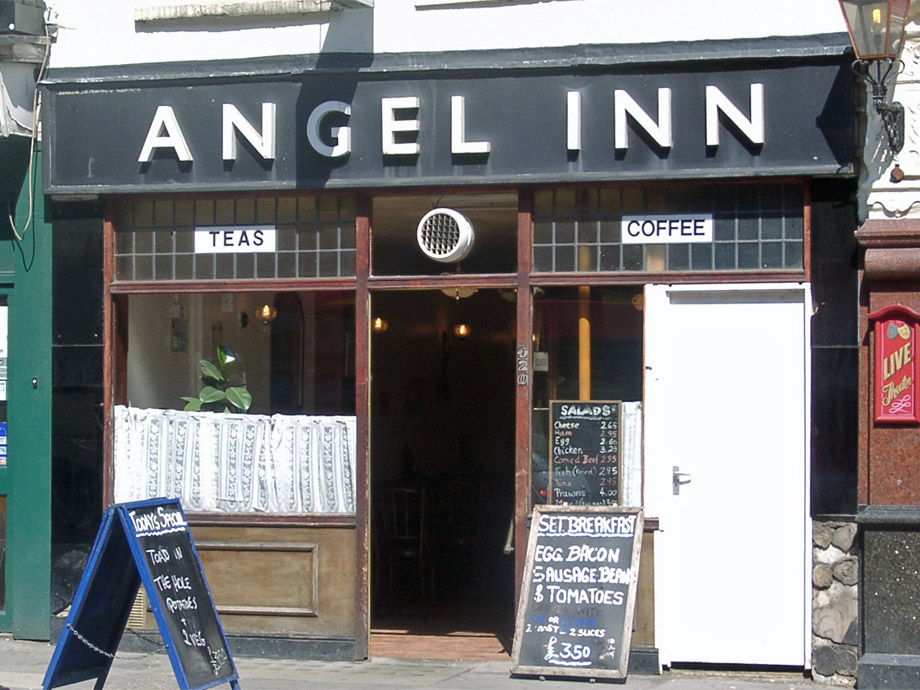
ISLINGTON CAFES
The Angel Inn on St John Street is one of the survivors (at least it was the last time I looked). The etched glass in the front door has since been replaced, and the interior now looks brighter and fresher than it did in 2001. The original Angel Inn was a hostelry dating back to the 17th century. It stood a short distance to the north and from it the district got its name.
Angel tube station was extensively redeveloped in the 1990s with the whole corner-block of buildings being knocked down, taking with them a well-known local pub called the Blue Coat Boy. The old tube station had an island platform with track on either side. In the early 1980s the station would sometimes fill with skinheads on Friday and Saturday nights, making their way to and from the Agricultural pub on Chapel Market, or the Aggrocultural as it became known.
Fights regularly broke out among them and on occasion the tube station would be temporarily closed while police dog teams were sent in to sort out the subterranean chaos. Angel station and its staff were the subject of a fine documentary by Molly Dineen, which you can watch on YouTube.
The pride of Islington’s cafes was Alfredo’s on Essex Road. This rhapsody in formica had closed by 2001 so I didn’t take any photos of it. Shortly afterwards the premises were taken over by a small restaurant chain called Sausage & Mash and they left intact the beautiful old interior. In turn, Sausage & Mash closed down and now there’s no sign left that Alfredo’s was ever there, but it remains immortalised in the film Quadrophenia.

Chapel Market once had several cheap cafes along it, including De Marco’s which was well regarded for its ice cream. Another cafe stood at the corner of Grant Street but it wasn’t much good – a market stallholder told me that there were alternatives to it, “such as hunger”. Also gone is the small pie-and-mash shop which I think was on White Conduit Street opposite the eccentric Costumier Furrier junk shop with its glass cases full of mangy-looking stuffed animals. The Manze pie shop is still there. In the 1980s a huge bearded man, like Geoff Capes, worked behind the counter. Pies were served in combinations of one or two, large or small. If you were foolish enough to ask for one small pie, he would look at you pityingly and mutter “Dear oh dear”. This was an effective sales tactic.
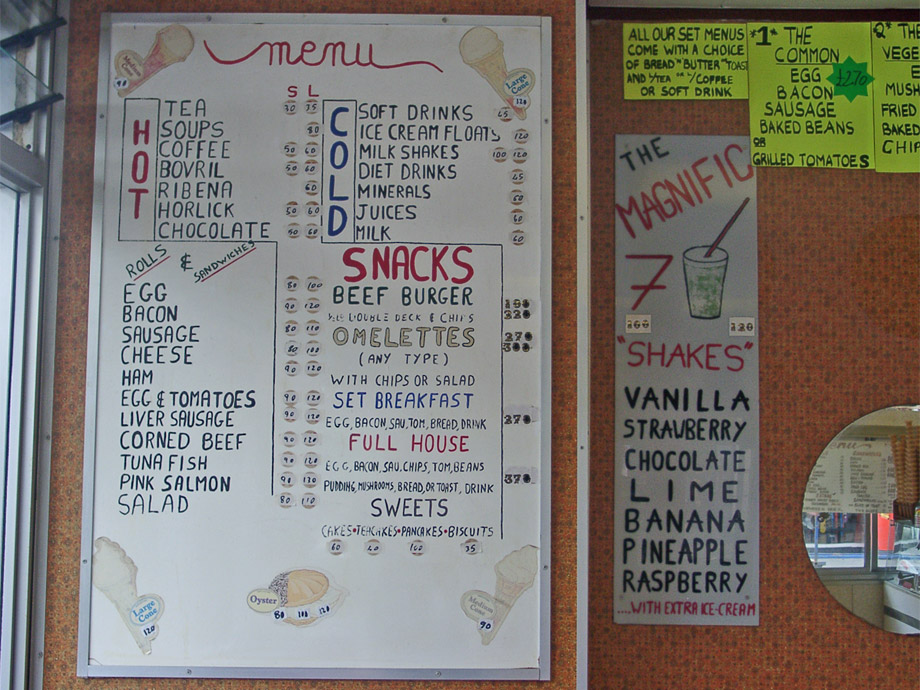
Fortunately the best cafe in the market, Alpino, has survived to the present and is thriving. The mixture of Italian pasta staples, English fry-ups and decent coffee appeals to market traders and office workers alike.
On the east side of Upper Street, almost opposite the Screen on the Green, was a cheap Turkish cafe which has long since gone. This was very plain inside, with the only decoration I can recall being a faded tourist board-type poster showing a photo of a lake with the word ‘Turkey’ at the top. A black-and-white TV was mounted high up on a corner shelf. It was always switched on but no-one seemed to pay any attention to it. The food was good.
Also gone is the small Cross Cafe in Cross Street, a short distance to the north. The kind of shops that are there now are more upmarket than they used to be. On the west side of Cross Street are some quite grand townhouses and it’s surprising to recall that in the early 1980s several of these were squatted and then occupied by a housing co-op founded by punks whose members paid only a very modest rent. Cross Street was also the victim of a curious crime which plagued parts of Islington in the late 1980s and early 1990s – the theft of old stone paving slabs. The slabs were believed to be sold on by garden centres or else were stolen to order.
Holloway Road had then and still has many cafes along its length. Some, like the Hope Workers Cafe, have become minor local institutions. The Panda Restaurant was on a small side street leading west from Holloway Road. Inside it had a subdued atmosphere and a clientele of mostly elderly local residents.
The Shepherdess on City Road is another survivor in an area which has changed a great deal over the last two or three decades. Like Alpino, it’s been able to appeal to a wide range of customers, from the staff of the large laundry which used to be towards the southern end of Windsor Terrace to those working today at the various design and photographic studios nearby.
It’s always been ram-packed at lunchtime, but in the early afternoon things start to quieten down and it becomes a place to sit and chat or while away the time, something for which cafes are often better suited than pubs.
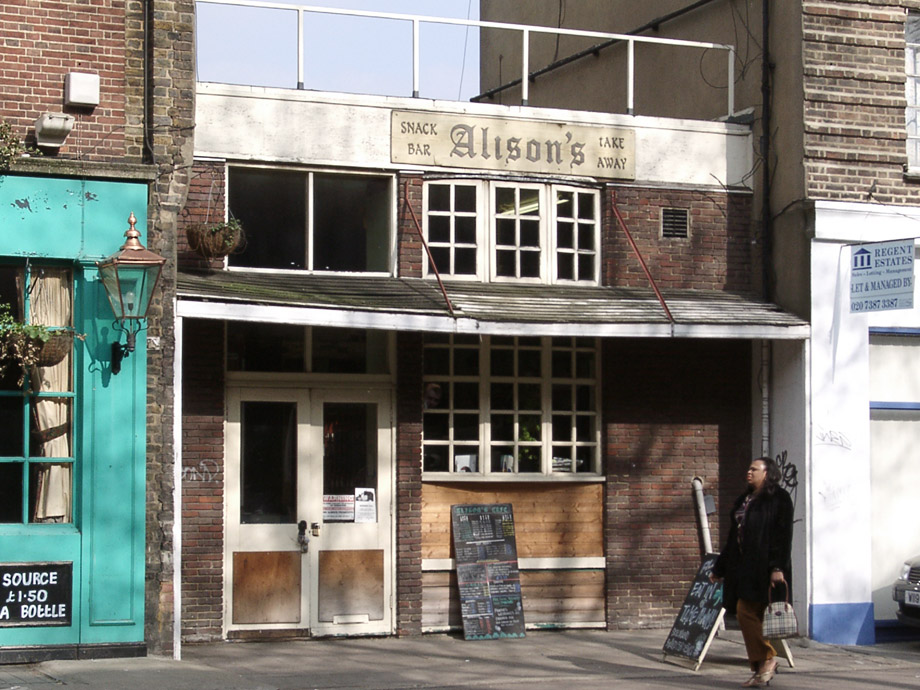
EVERSHOLT STREET CAFES
In the mind’s eye of a developer, Eversholt Street is the hub of the vibrant EuHu Quarter, filled with fashionable boutiques and coffee bars decorated inside with signs reminding customers they can Relax, Chill, Nourish, Refresh, Imbibe, and Energise. Perhaps similarly instructive words could be displayed in the bogs?
The real, current Eversholt Street forms the eastern boundary of Euston station, which presents a generally featureless wall along much of the street, punctuated by nondescript staff-only doors and a goods entrance. Opposite is a terrace with pubs, shops, cafes and offices on the ground floors, and flats above.
Alison’s cafe, pictured above, was towards the north end of the street. It had a curious arrangement inside with a raised floor at the rear of the premises on which there were maybe three or four tables. It was tidier inside than you might expect from its exterior.
The Double Six is a long-established cafe that’s still around. The counter is on the left-hand side as you walk in, and there’s fixed padded seating upholstered in green hide-effect vinyl. A single step goes down to a rear seating area which has a cosily conspiratorial feel. The Double Six is popular with cab drivers.
Some years ago I had the pleasure of meeting Adrian Maddox, responsible for the Classic Cafes, a gem of the internet’s golden years before the social media treadmill got started. Adrian was a witty raconteur and made for good company. He also had a huge tolerance for tea, drinking perhaps seven or eight mugs in the space of a couple of hours. I tried to keep up with him but, after we left and went our separate ways, I had to dart inside an alleyway near Chalton Street to expel a big whoosh of Thames-coloured sick.
A little further south towards the Euston Road end is the Victory Cafe and, like the Double Six, it remains in business. A friendly Italian couple ran it, the husband being happy to talk with me about the business while his wife was more shy and preferred to stay in the kitchen at the back. A nearly full-size poster of Sophia Loren was stuck next to the kitchen door.
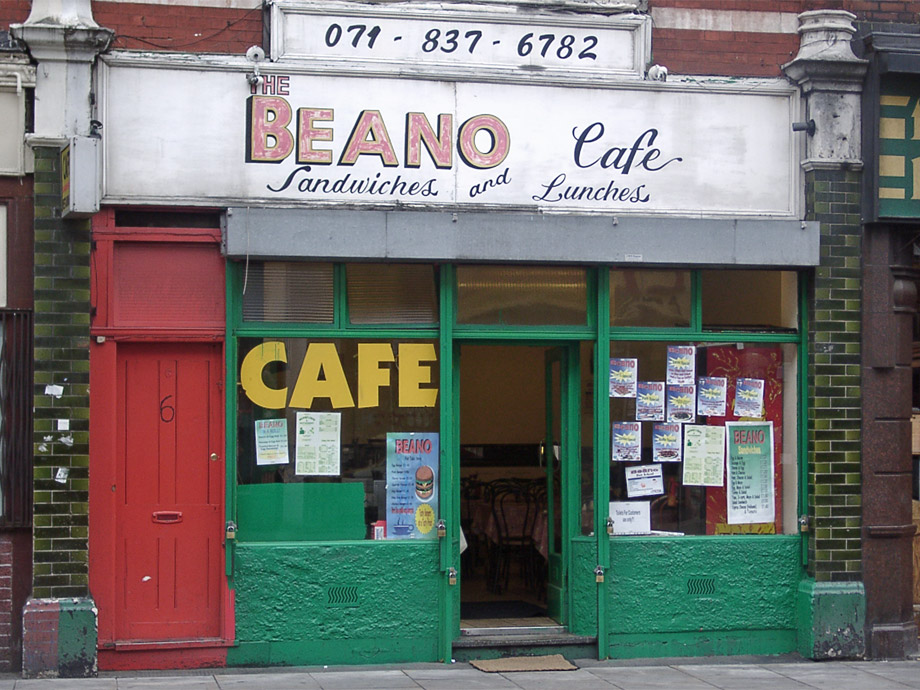
MORE KINGS CROSS CAFES
The Beano was at the southern end of Caledonian Road and underwent regular alterations to its signage and outside paintwork. The staff were cheerful but the food was very greasy and had to be chased around the plate with the fork. I only ate there once or twice. Immediately to the right was the Flying Scotsman pub, now refurbished and returned to its original name of the Scottish Stores. Back then the Flying Scotsman was a strippers’ pub and had a clientele drawn from the ranks of disoriented tourists, some of the area’s more recognisable beggars, the curious, and those who tried to get as close as possible to the little stage. Once in the front row, these men gazed in wonder at each woman as she went through her routine. A respectful round of applause followed every act and one of the strippers would go around the pub with a pint tumbler to collect money.

Before St Pancras station was reinvented as an upmarket Eurostar terminal, the arches beneath it were occupied by various small enterprises, including taxi garages and cafes. Further north, the arches grew into an extensive subterranean warren of tunnels. One of the cafes, the name of which I can’t remember, overlooked Euston Road, the other was the Railway Cafe on Pancras Road. The Railway Cafe was closed quite early during the station’s redevelopment to be used as a headquarters for the site’s security guards. This marked the end of the cafe’s life, which had been run by the same family since the late 1950s. The inside was plain, clean and quite roomy.

The area to the north of Kings Cross has changed out of all recognition in recent years, while developments east of York Way have been more piecemeal. Housman’s Bookshop on Caledonian Road still hangs on, while the Continental Food Stores deli has closed for good following a brief afterlife as some kind of art gallery. The Ancient Black and Mole Jazz record shops have gone. The hegemony of pricey hamburgers, once confined to south-west London, continues its expansion into Kings Cross with branches of Five Guys and Honest Burgers.
Nearby, on Kings Cross Road, was Bar Uno run by a nice Italian lady named Maria. The premises had a long history of cafe use, operating in earlier years as the Beehive and, in the 1950s, as the A1 milk bar.
Maria had filled her snack bar with small mementoes of Italy, like this plate depicting Ravello on the western coast around thirty miles south of Naples. I forgot to ask her whether she herself was originally from Ravello. The majority of Italian cafe owners in London seemed to come from the south of Italy. Her son eventually took over the running of the snack bar and it’s still there today under a new name.
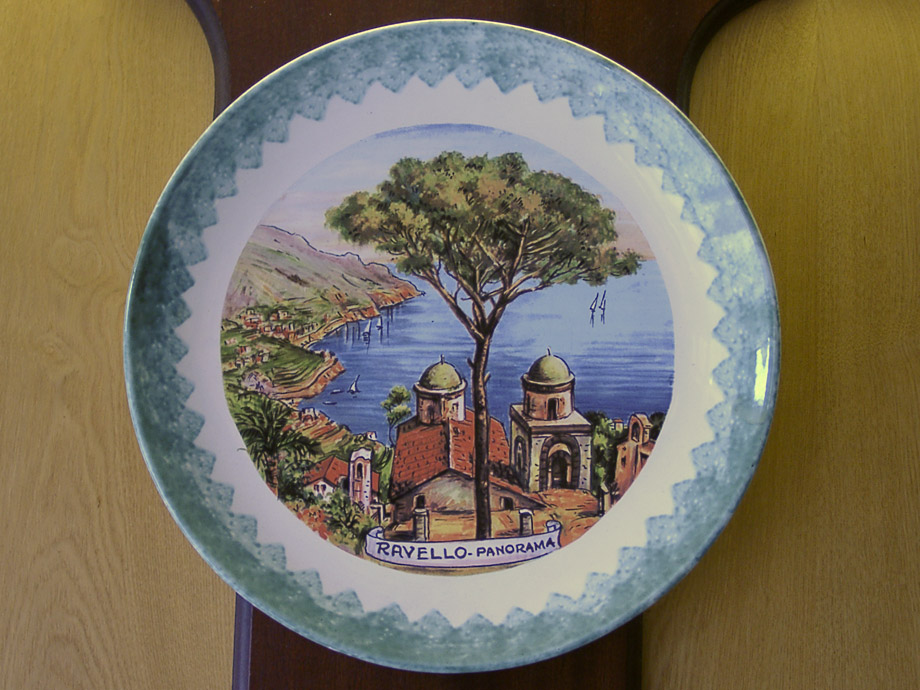
The words ‘dining rooms’ in a London cafe’s name suggests an origin in the pre-Second World War period. As well as the Times Dining Rooms of Hammersmith, mentioned in the introduction, a ghost sign for another set of dining rooms can still be seen above the Corner Cafe on Queenstown Road in Battersea. Simmons of Caledonian Road with its vintage sign, reminiscent of the type used by some pie and mash shops and the old Kennedy’s butchers shops in south London, may have had a similarly early beginning. By 2001 it had closed but curiously seemed immune to being taken over and remained shut for several years. Perhaps some kind of legal complication was the reason.
Today, Simmons is now a small bar and the current owners have had the presence of mind to keep the original name and sign.
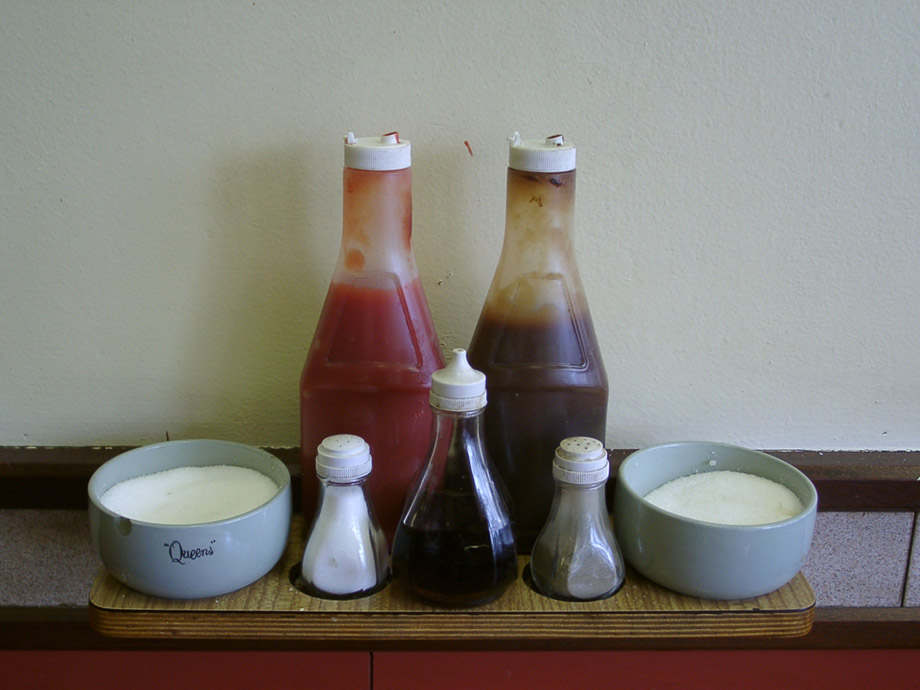
MODERN SNACK BAR, KINGS CROSS
The Modern Snack Bar was on Pentonville Road by the junction of Kings Cross Bridge, possibly one of the least healthy spots in London in terms of air quality and the physical condition of many of its habitués. However, all this could be forgotten once you were inside the cafe, which extended back a surprisingly long distance.
I found the owners to be talkative and approachable, which seemed only fair given the amount of money I’d spent in there since the early 1980s. They told me proudly that they’d once had another cafe somewhere off Piccadilly where Princess Diana was a regular customer in her pre-marriage sloane ranger days. The cruet sets were brought from there to Kings Cross: the sugar bowl bears the name “Queens”.
The orange plastic lettering was a recent feature in 2001. Only a year or so before the Modern Snack Bar displayed a much more attractive sign with Art Deco-style raised letters on a green vitreolite background. Why had they changed it? Something was said about the local development agency encouraging them to do so. In later years the cafe somehow lost more than half its floor space and the interior became brighter and less cosy. It was no longer a place to relax in.
Immediately to the south was the Scala Cinema, popular for its all-nighter sessions when it screened Russ Meyer films and enjoyably ludicrous fare like Plan 9 from Outer Space and Wild Women of Wongo. You could of course smoke in cinemas then, the only limitation being a no-smoking area which made as much sense as having a no-pissing end in a swimming pool. Some young cinéastes were occasionally sniffed out and ejected for trying to enhance their critical faculties by furtively smoking Lebanese hash.
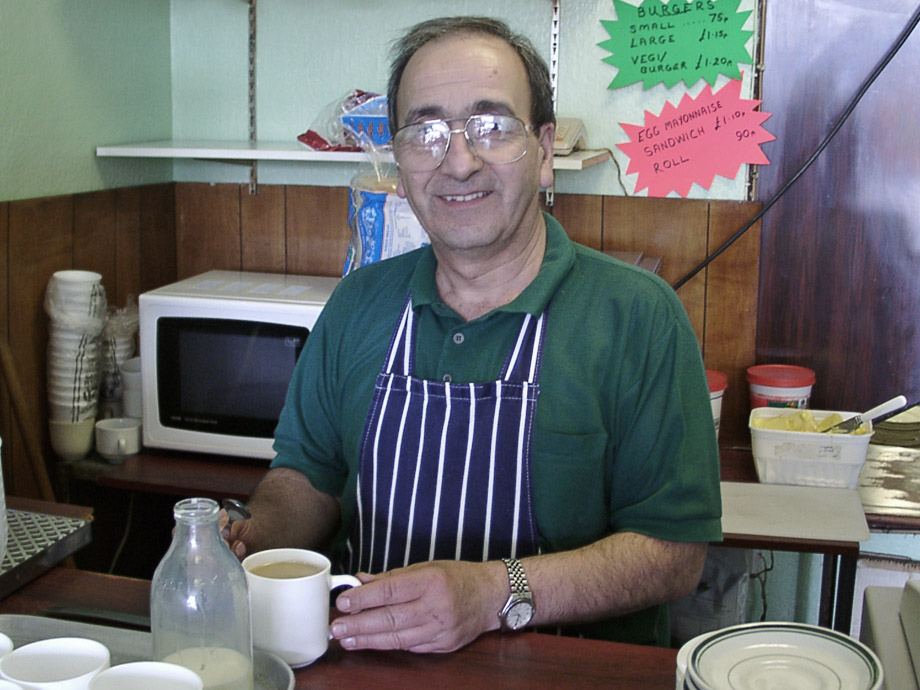
GEORGE'S RESTAURANT, KINGS CROSS
George’s Restaurant was on York Way in Kings Cross near the junction with Wharfdale Road. By the time I got there the business had been passed on to Andy (pictured above) who I think was George’s son-in-law. Andy was a friendly man and I liked going in there. With its sun-scoured Pepsi sign and clean, plain interior, George’s looked like many workmen’s cafes from the 1970s but, because of its location, it attracted a varied clientele.
Andy told me that he had regular customers from a nearby dance studio, in the past including Tamzin Outhwaite, who by the time we spoke was appearing in EastEnders. Then there were office workers and staff from Kings Cross station, even a few tourists. Years before, there had also been prostitutes coming in for something to eat before they started their work in the evenings. “They were nice clean girls back then,” Andy said, “not like the ones you see now, the state of them.”
From inside, you could look westwards to the Kings Cross gasholders and the old tenement blocks along Battle Bridge Road. These were demolished in 2008 and George’s Restaurant went around that time too.
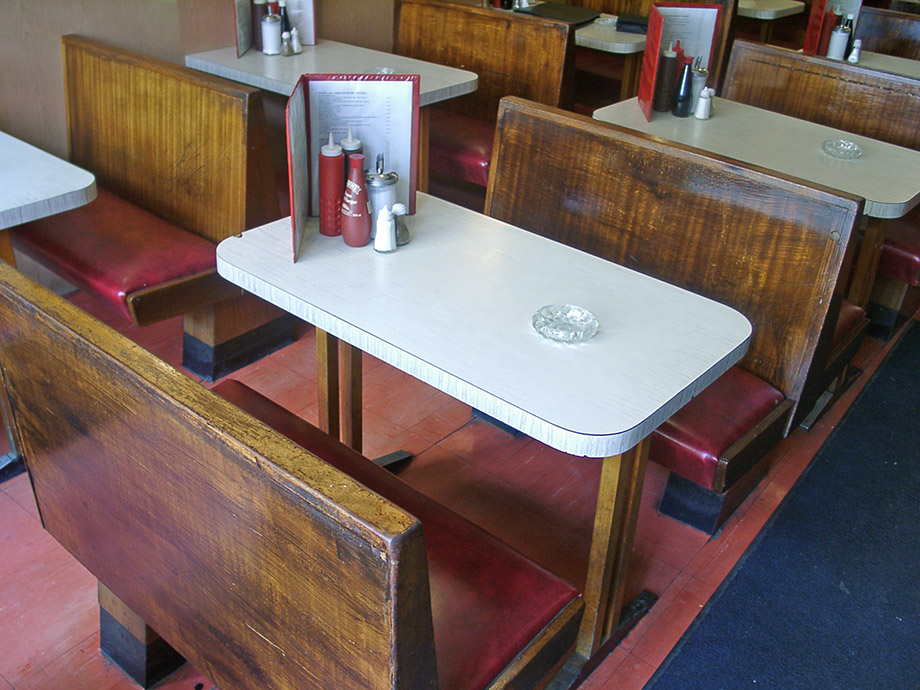
INTRODUCTION
This section presents some photographs I took in 2001 of traditional-style London cafes. Scroll down the page for thumbnail links both to individual cafes of note and to other pages where more cafes are lumped together by district.
Some of the cafes were large, some tiny. Some were plain and spartan inside, others had a friendly clutter of pictures and ornaments. Many were run by Italians, some by Cypriots, a few by English people. Despite their differences they all tended to be cheap, unpretentious and independently-owned. The cafes often possessed that sense of being a part of their surroundings from having settled in over the decades. Their clientele included tradesmen, postmen, office clerks, young mums with their kids, pensioners, doleys on giro-day blow-outs: all sorts. I felt drawn to them because they were echoes of the scruffy, fascinating city I’d begun to explore as a child in the 1970s. Also, just pleasant places to pass the time of day in.
One I went to often in the early 1980s is a good enoough representative of some of these later survivors. Maria’s Cafe, also called the United, stood at the junction of Essex Road and Pickering Street in Islington. It was a few doors down from the greengrocers’ stalls at the end of Elder Walk. Maria was a cheerful Italian woman with strong-looking hands and forearms that had possibly been developed through wringing chickens’ necks in more rural surroundings. Her husband spent most of his time in the kitchen, handing out plates of food through a serving hatch.
They had three stocky sons who were all amateur boxers. Sometimes these lads hung around the cafe with their friends, proudly pointing out their names on the boxing match posters which were stuck to the walls or passing judgement on other contenders: “I’ve had him”. Maria and her husband served English fried breakfasts and some Italian dishes. My favourite was the lasagne, a portion being only a little smaller than an LBC house brick. Maria would sidle up to stand alongside me and grin. “You like?” she’d say. At the time I wasn’t sure if this was a question or a command, slow to recognise the maternal kindliness being offered to a streak-of-cabbage teenager. Different people now occupy the premises under a new name, the Angel Cafe.
Italian families like Maria’s have added a lot of small good things to the parts of London they’ve traditionally inhabited: cafes, restaurants, ice cream parlours, delicatessans. When I spoke to some of the cafe owners back in 2001, they explained that the tradition of running cafes was dwindling. Their children aspired to office jobs with better salaries and more reasonable hours. Instead the baton is being passed on to Cypriots, Turks and other people. English-run cafes were much rarer in central London than they were in the railway suburbs or further out. There was one in the 1980s close by Highbury & Islington station, and I remember several more around Hammersmith in the 1970s.
The Times Dining Rooms were on Shepherds Bush Road, a short distance north of the junction with Brook Green. Today it’s an affluent area but at the end of the 1970s it had the seedy, run-down feel common then to much of inner London. You can glimpse this in films like Withnail and I, episodes of The Sweeney and occasionally location shots in Steptoe and Son from the streets of Notting Hill and elsewhere in west London. I’d visit for a post-shopping treat after buying secondhand paperbacks in the nearby Popular Book Centre. A cup of stewed tea and slice of bread-and-marge complemented the works of James Herbert, Philip K. Dick, Michael Moorcock, and the Pan horror compilations that had on their covers a photo of a goat’s head surrounded by black candles, or a tarantula crawling across a baby-faced Victorian doll.
Everything inside the Times Dining Rooms – walls, furniture, people, food – seemed to be covered with a thin yellowish film, probably a combination of nicotine and the greasy hydrocarbons exhaled by the cafe’s gas stove. Next to the counter hung a long strip of fly-paper with its harvest of captives, either dead or wriggling their way down the spectrum of exhaustion like unhygienic clockwork toys. It brought to mind the expression ‘flies’ graveyard’, a humorous term for spotted dick pudding, which, coincidentally or not, was on the menu. The proprietor was a man in a grey warehouse coat who spoke little.
Several of his regular customers were older men of a type you don’t see any more. They tended to be thin and pale, and respectable in appearance if seen from a distance. Closer examination revealed grimy shirt collars, trousers that were a little too short, stained ‘Lord Antony’ anoraks or raincoats worn even in dry, warm weather. Sometimes I had seen one or two of these men in the Popular Book Centre, where the shopkeeper would usher them through a doorway at the back of the shop. What lay beyond was an unseen and esoteric realm, as the doorway had a hanging curtain of multicoloured plastic strips which blocked the view. I once tried to approach it but the shopkeeper moved quickly in front of me. “No, invited customers only,” he said.
Cafes were bound up in the activities of their surroundings, minor emblems of a plebeian London of cavernous pubs, street markets, army surplus stores, bingo halls, dog tracks, hoardings lacquered with gig posters, junk shops with their old fridges and sofas on the pavements outside. This world was not representative of the city as a whole but it was a significant part and many people had an understanding of it. London now seems harder to know because it has become much more cosmopolitan and because wealth and modernity bring with them private ways of life. Perhaps this is why many blogs and websites about London concentrate on its past, on impersonal unifying symbols, or buildings, places and other containers for people instead of the people themselves.
The pictures presented here are now sixteen years old. Some of the cafes have survived, others have changed hands and names since then, many have disappeared altogether. To those running them who gave me a little of their time, my thanks. Better late than never.
